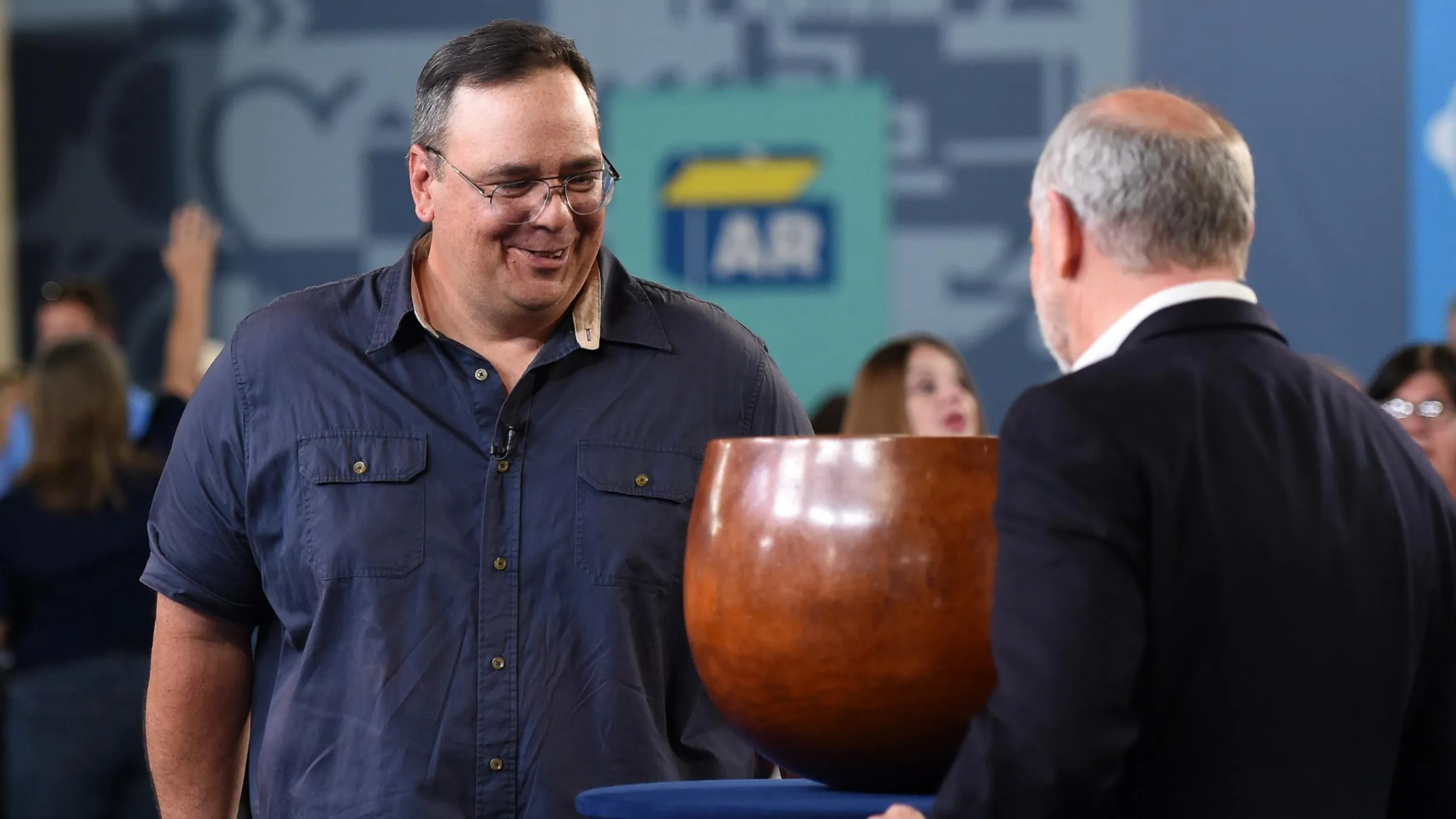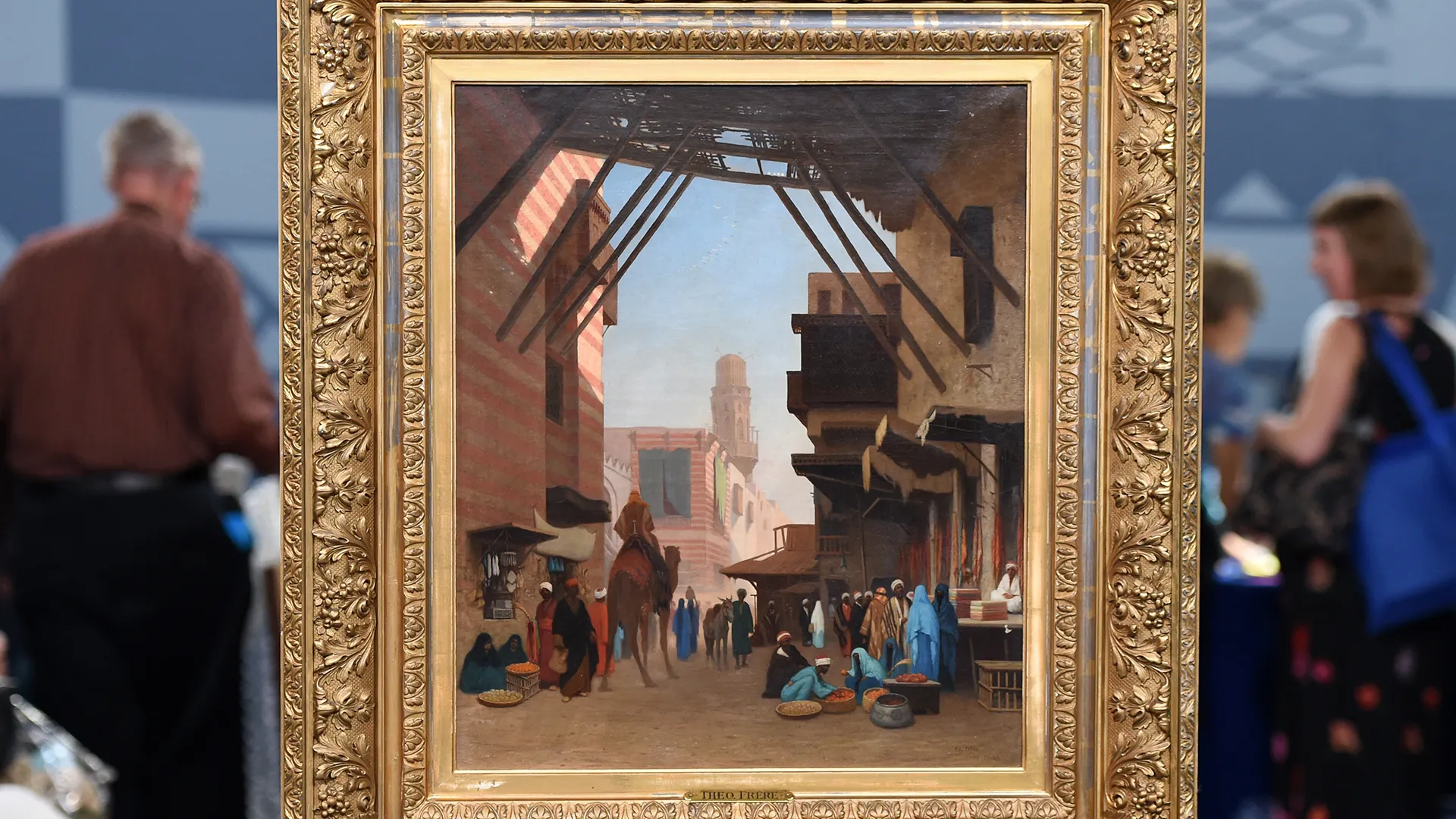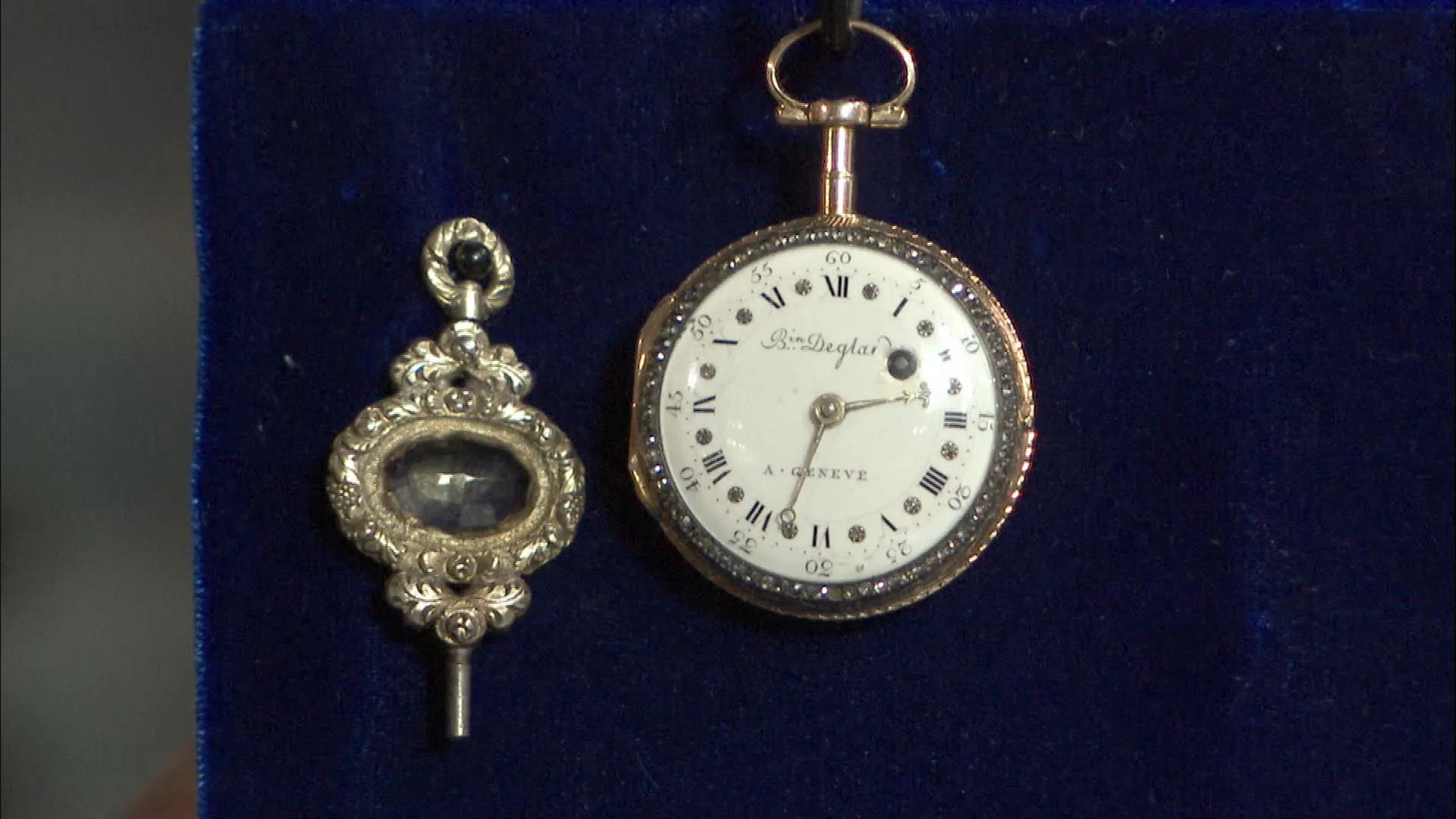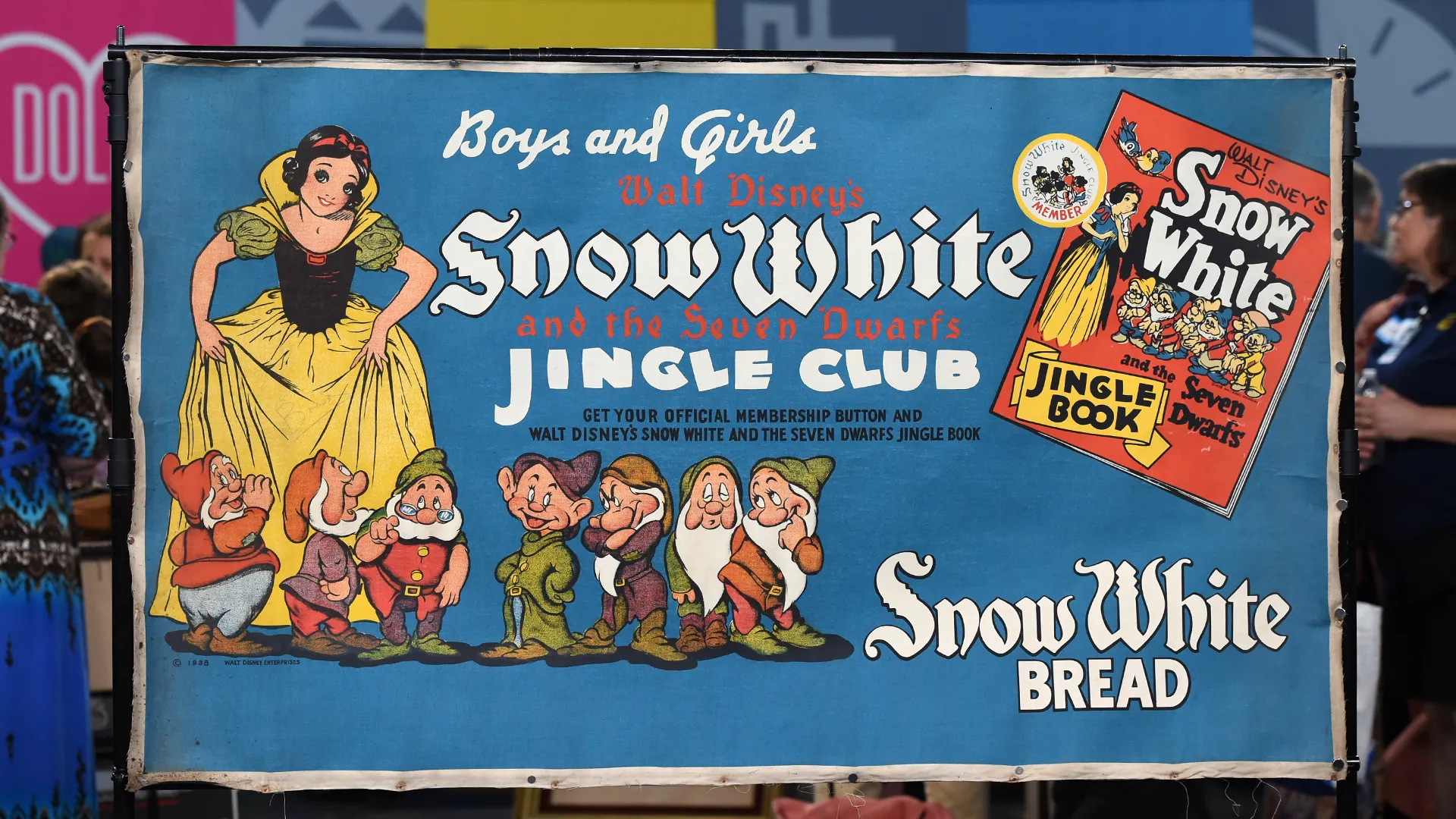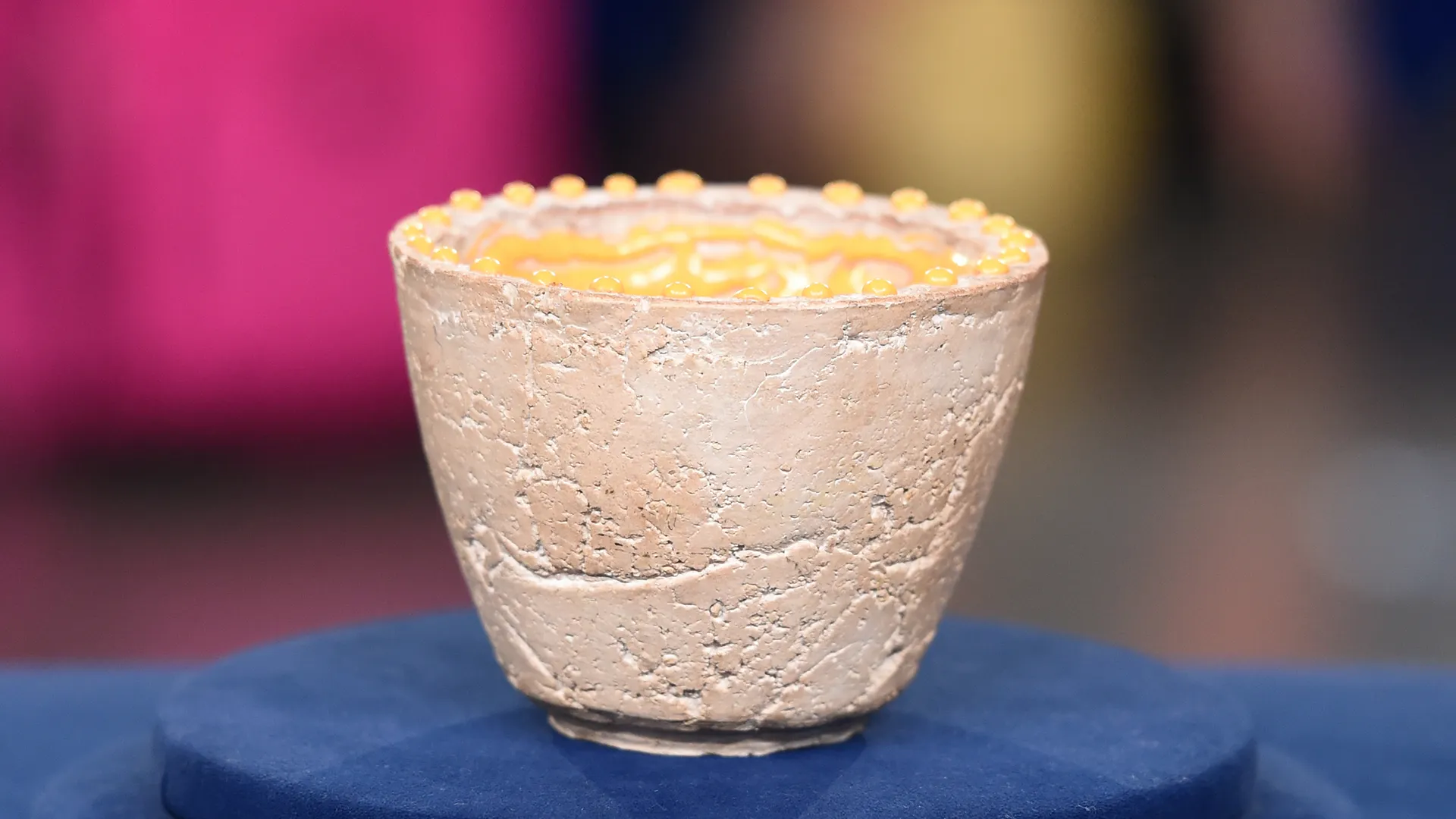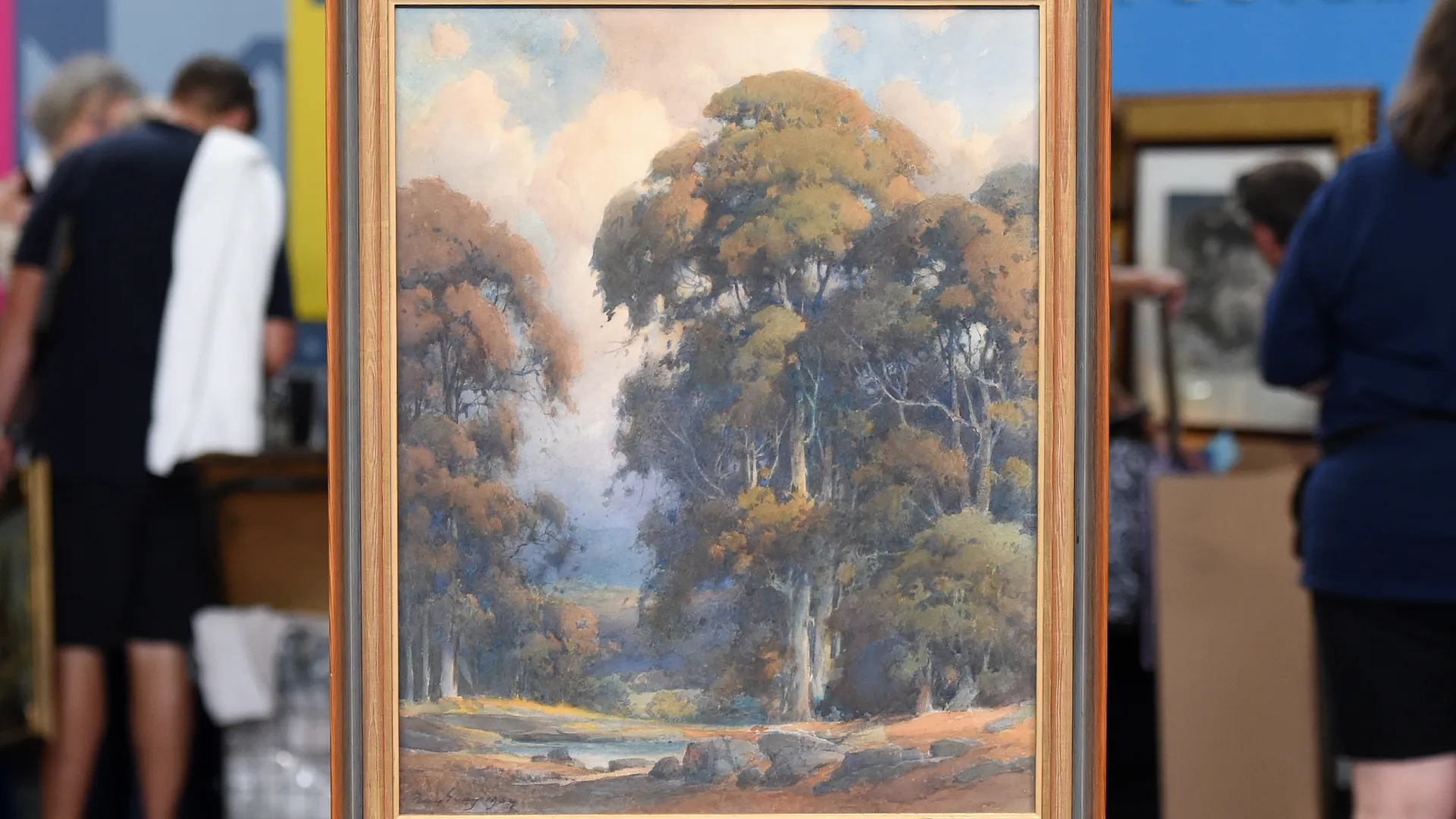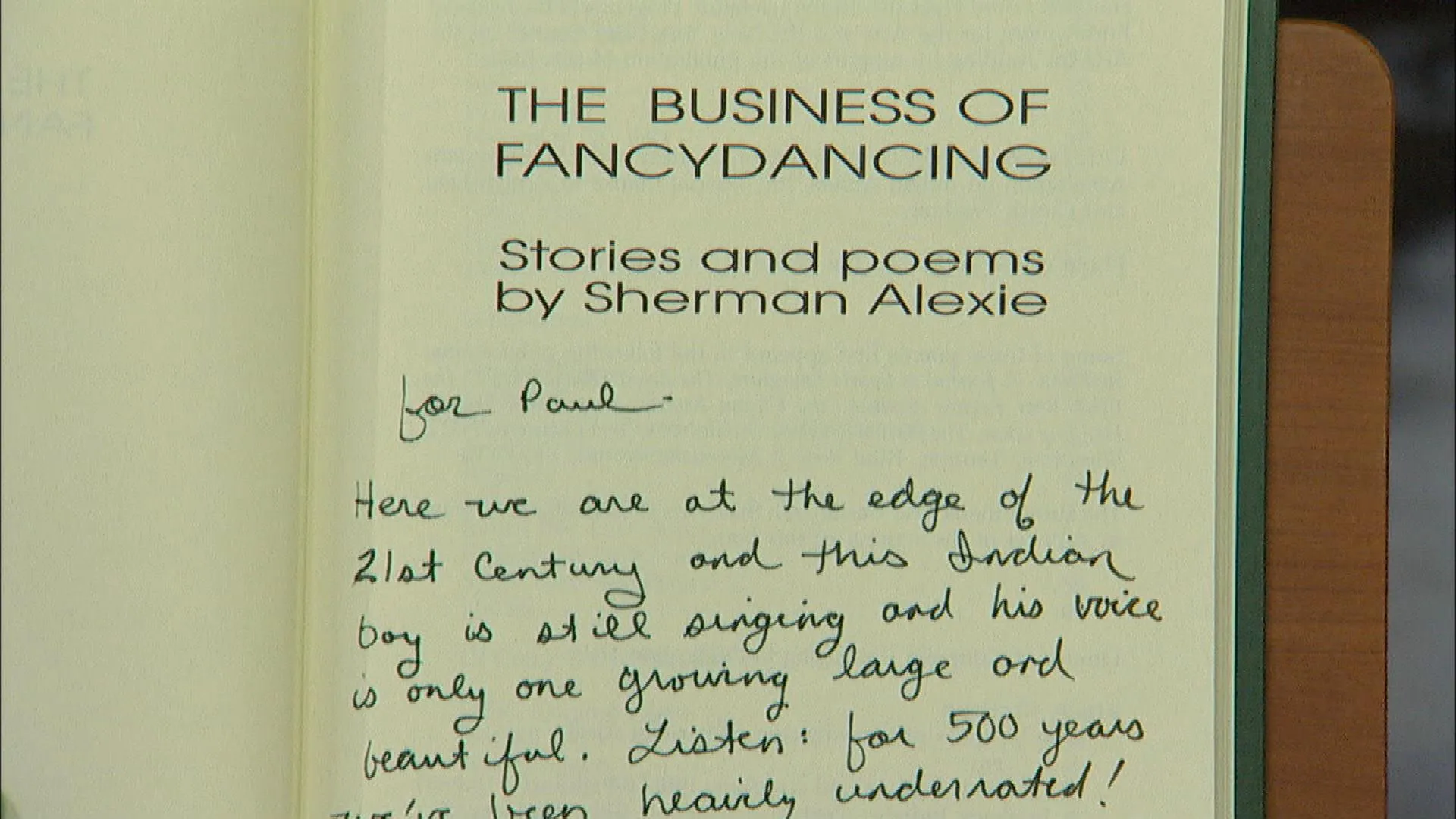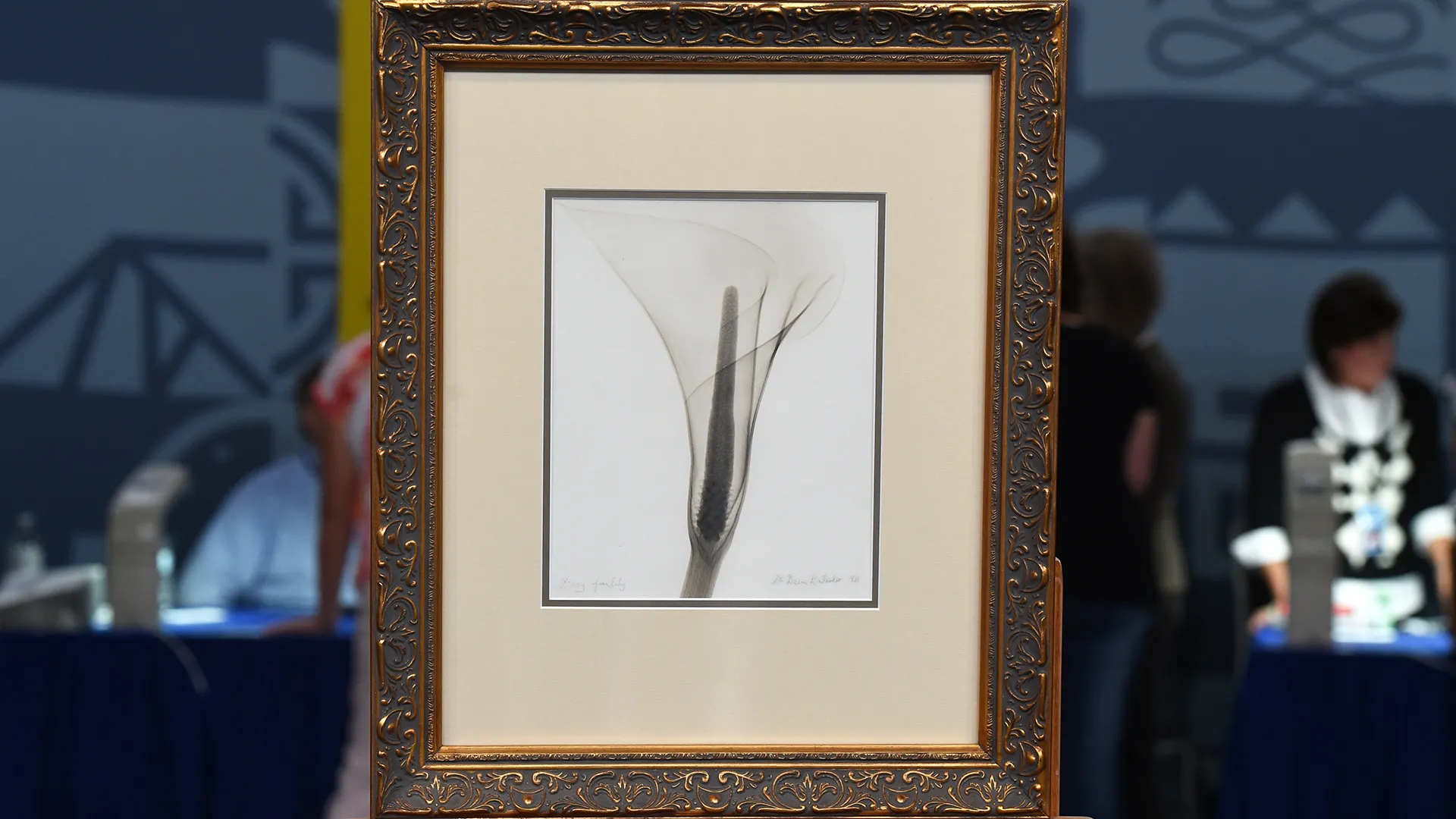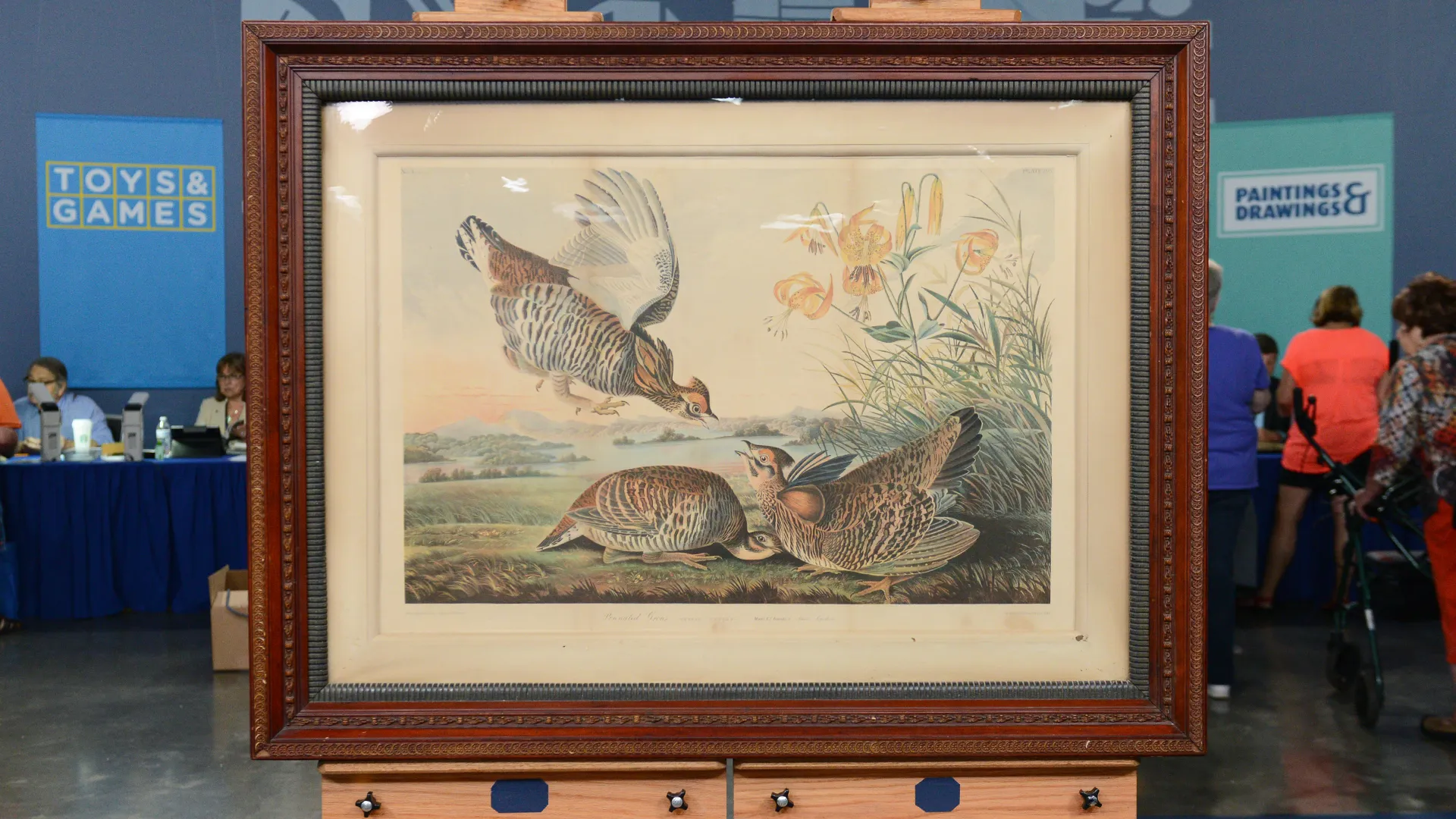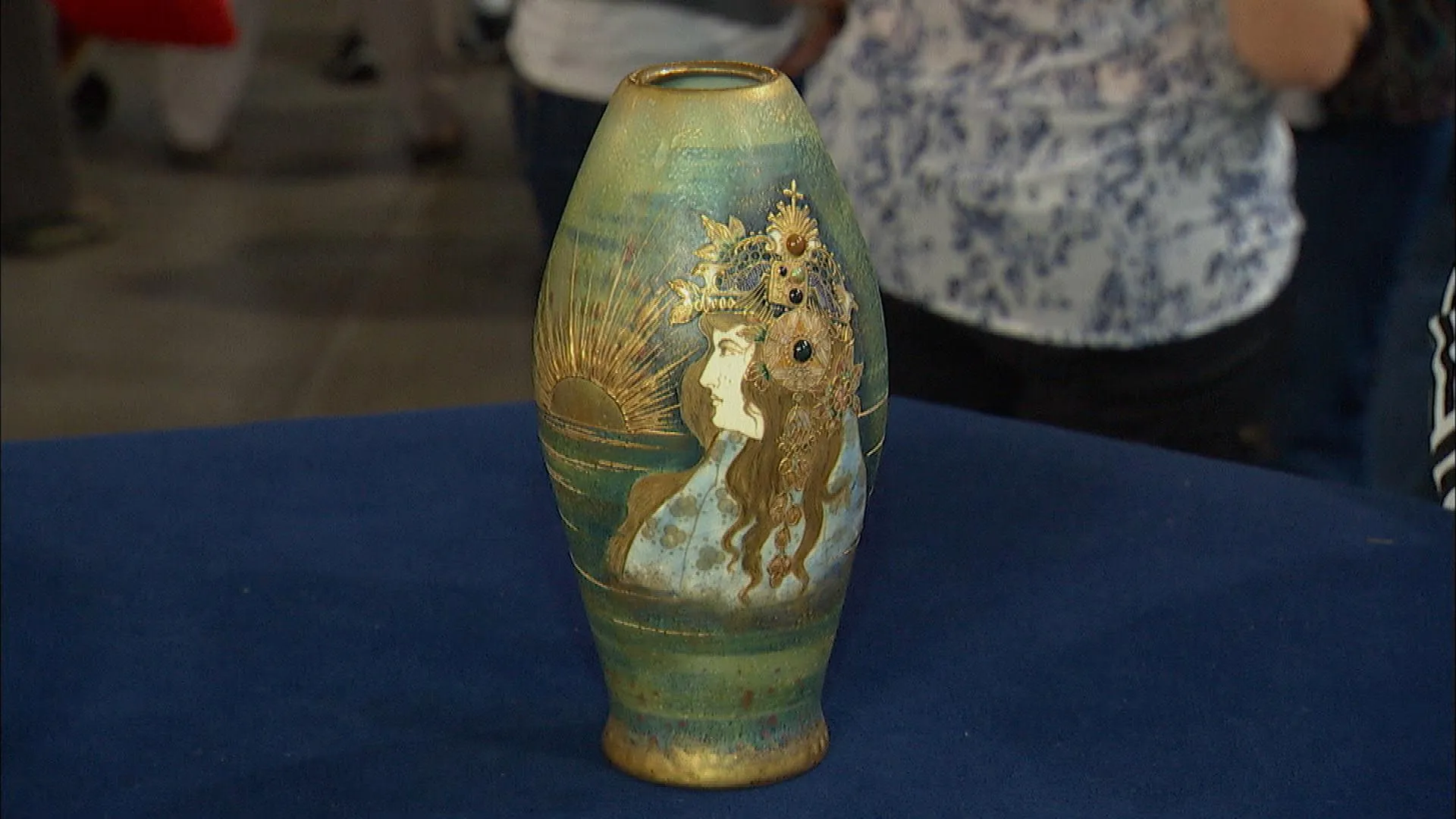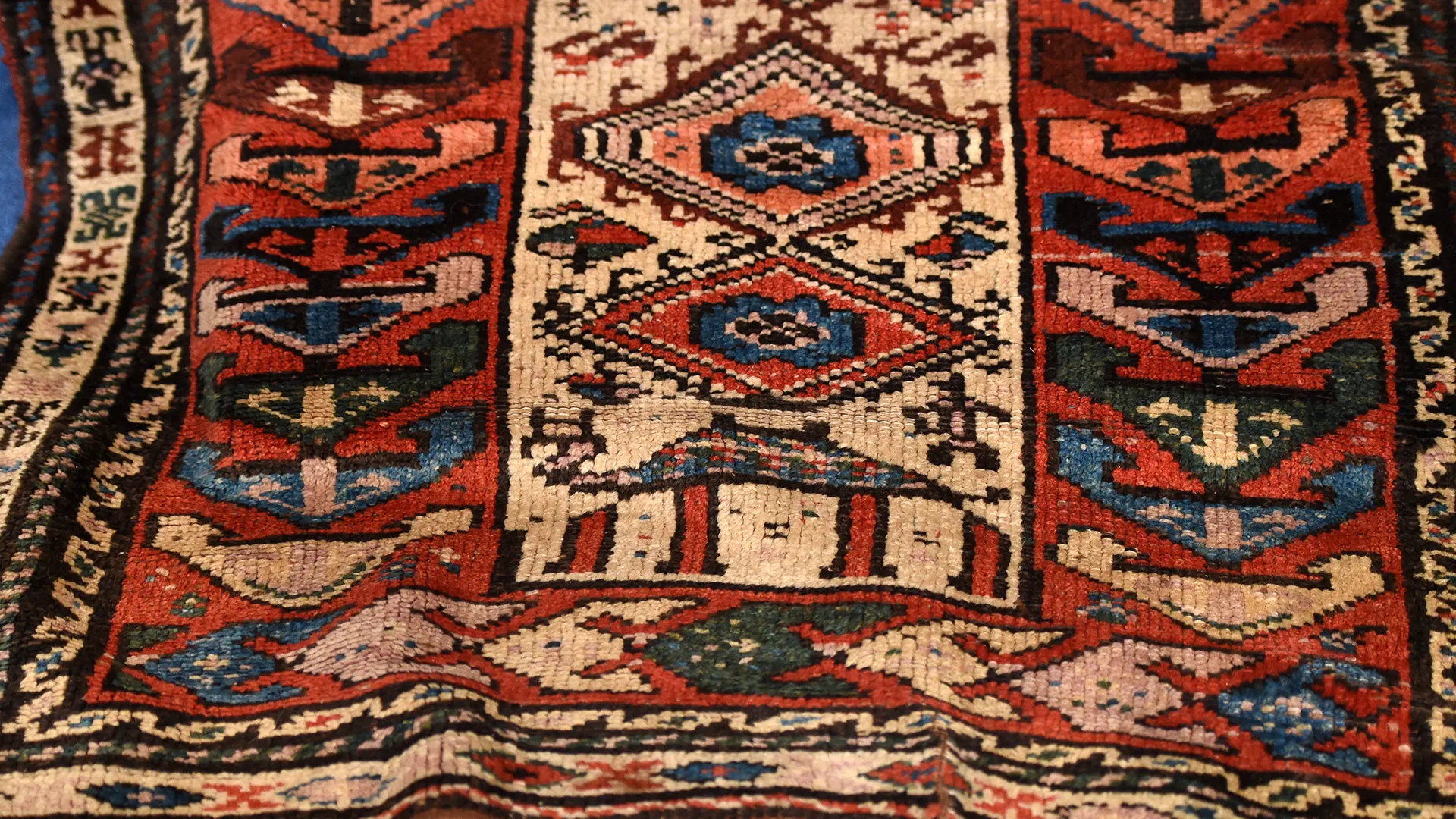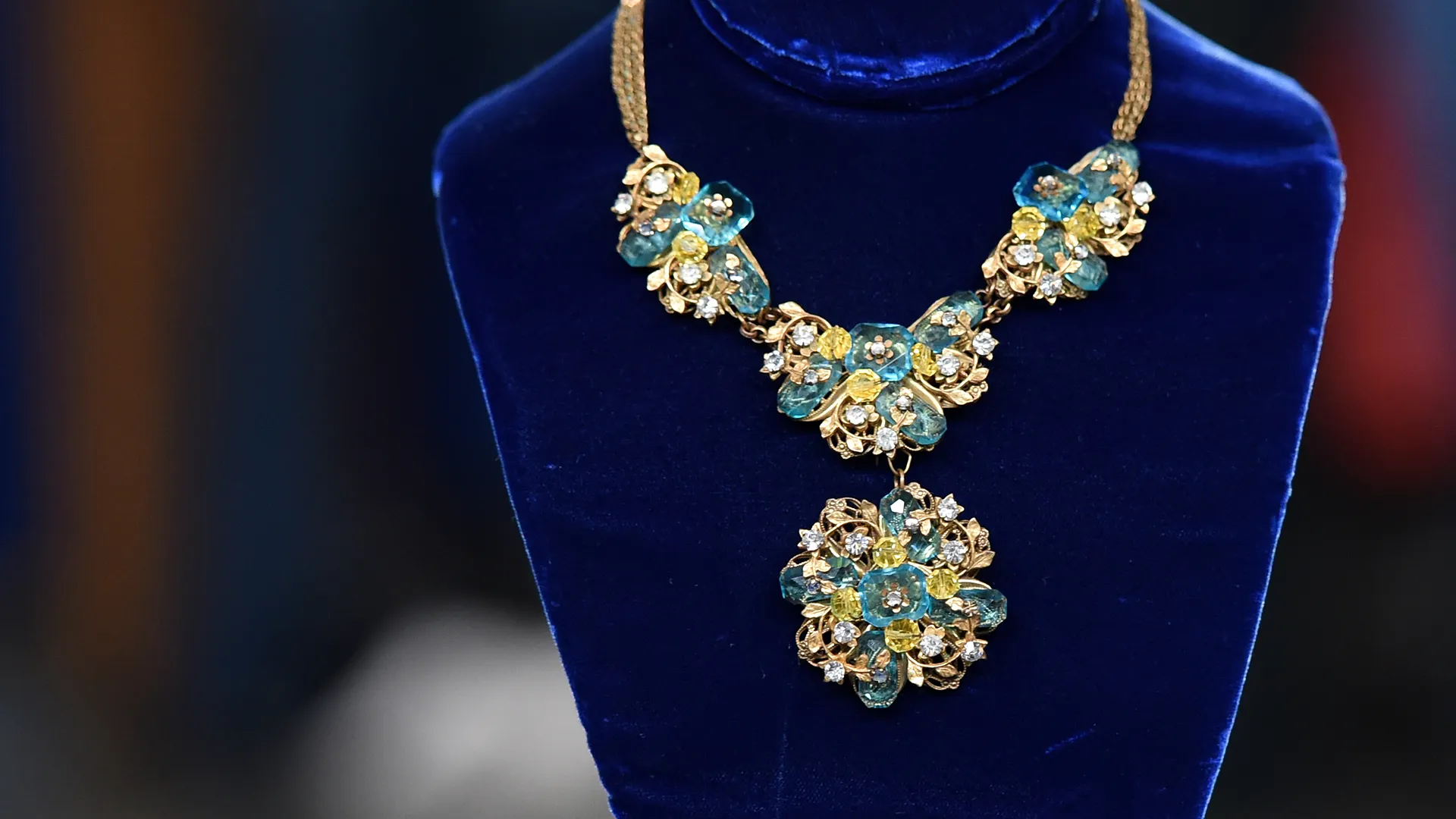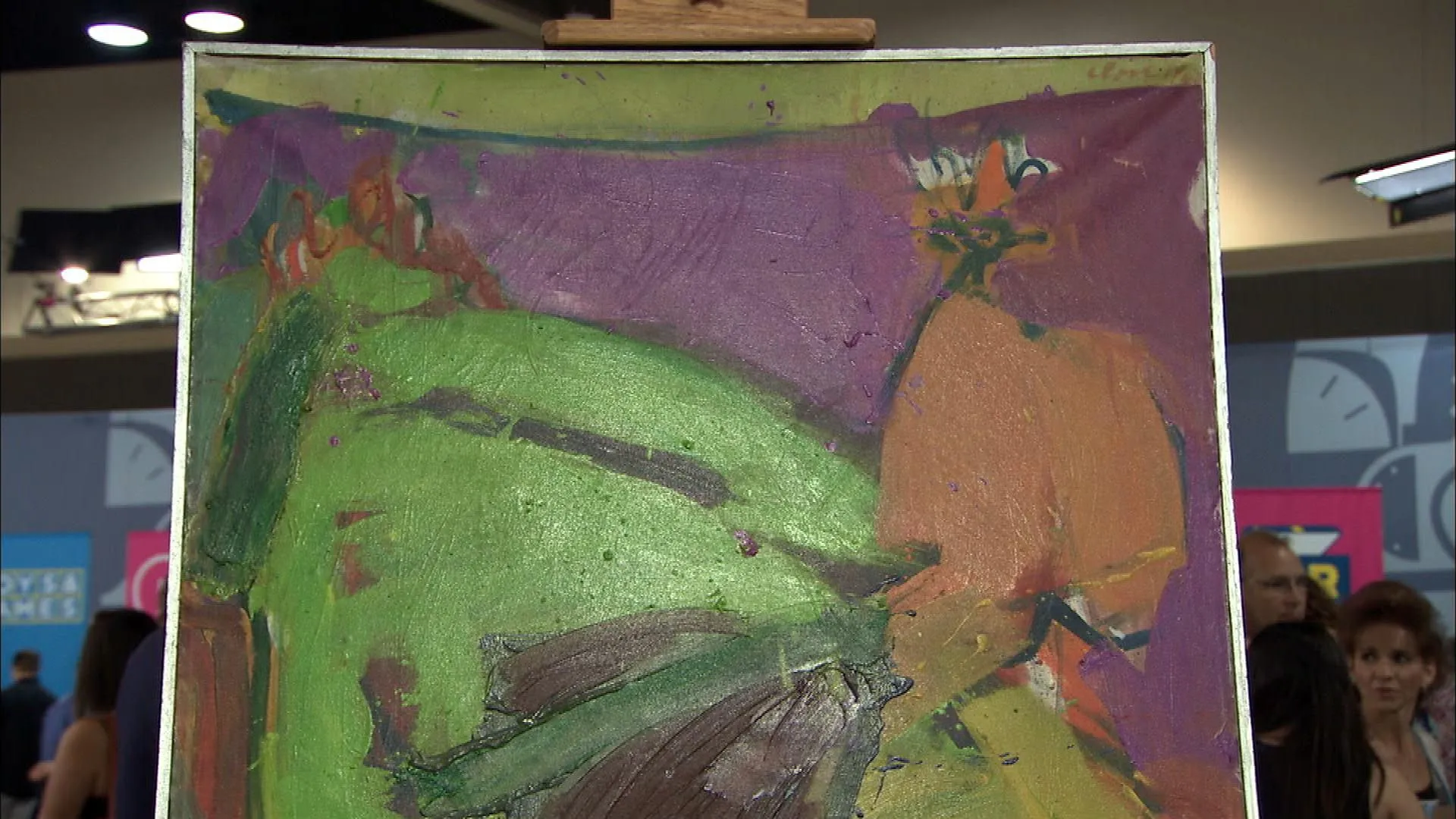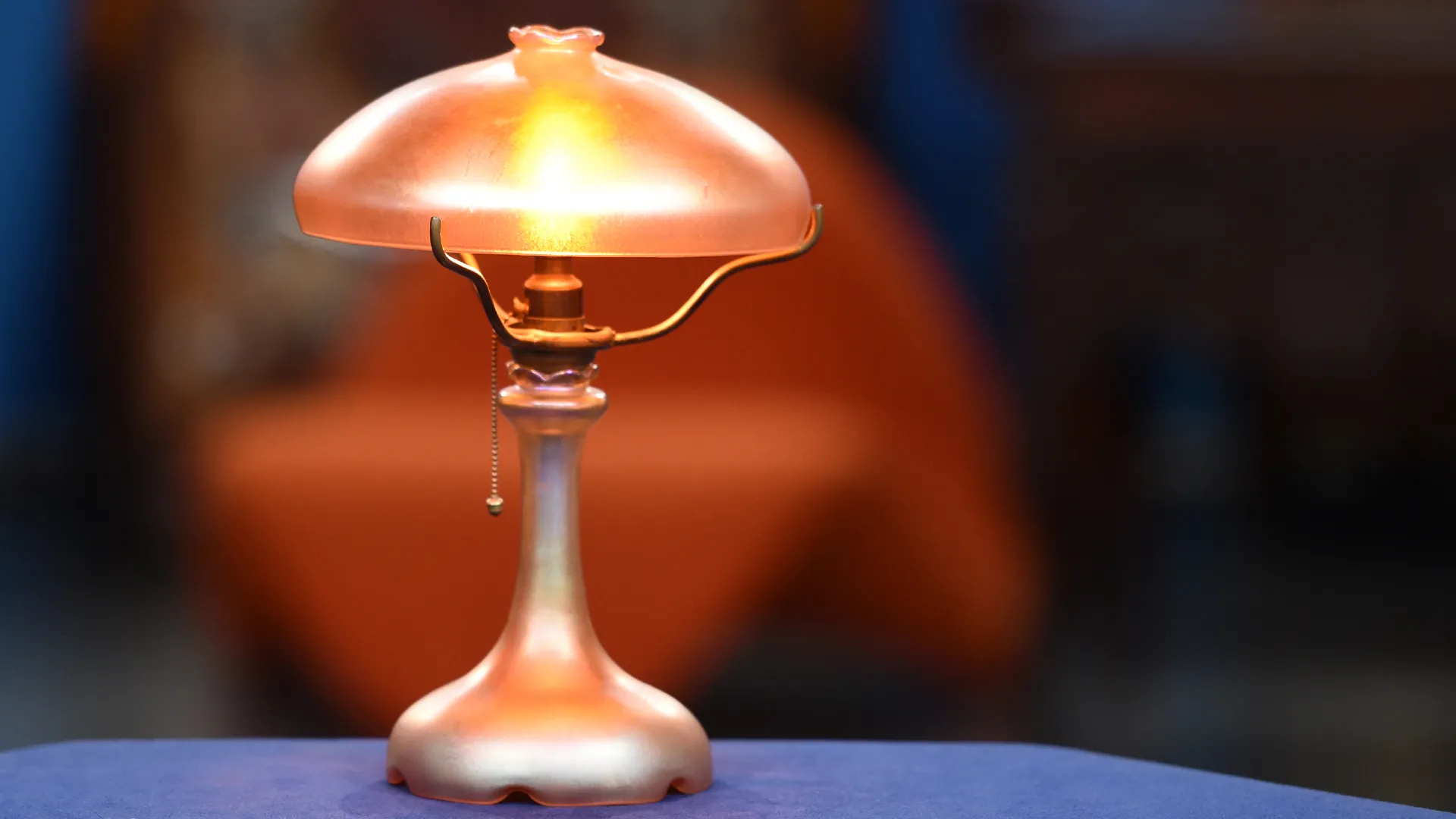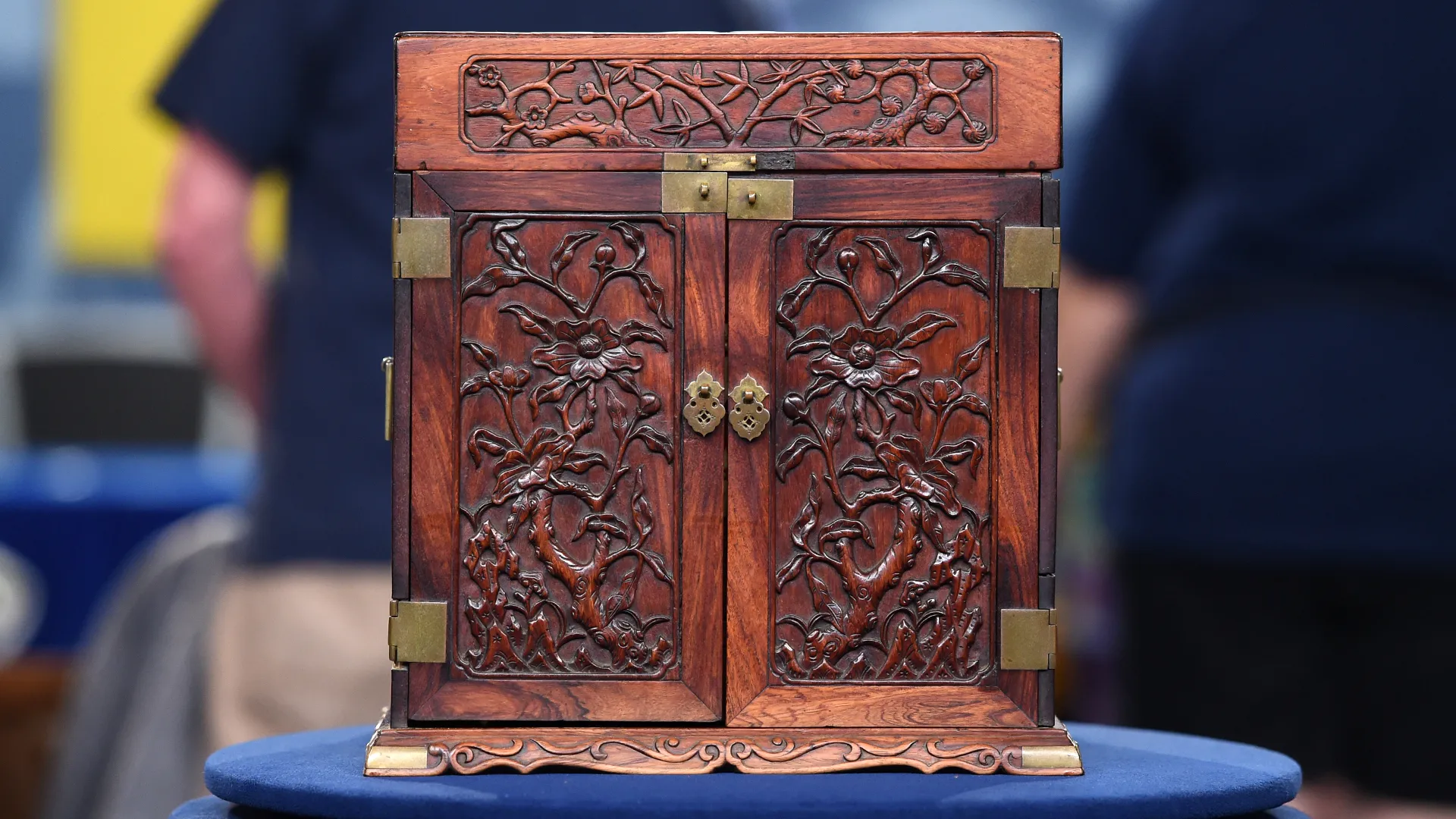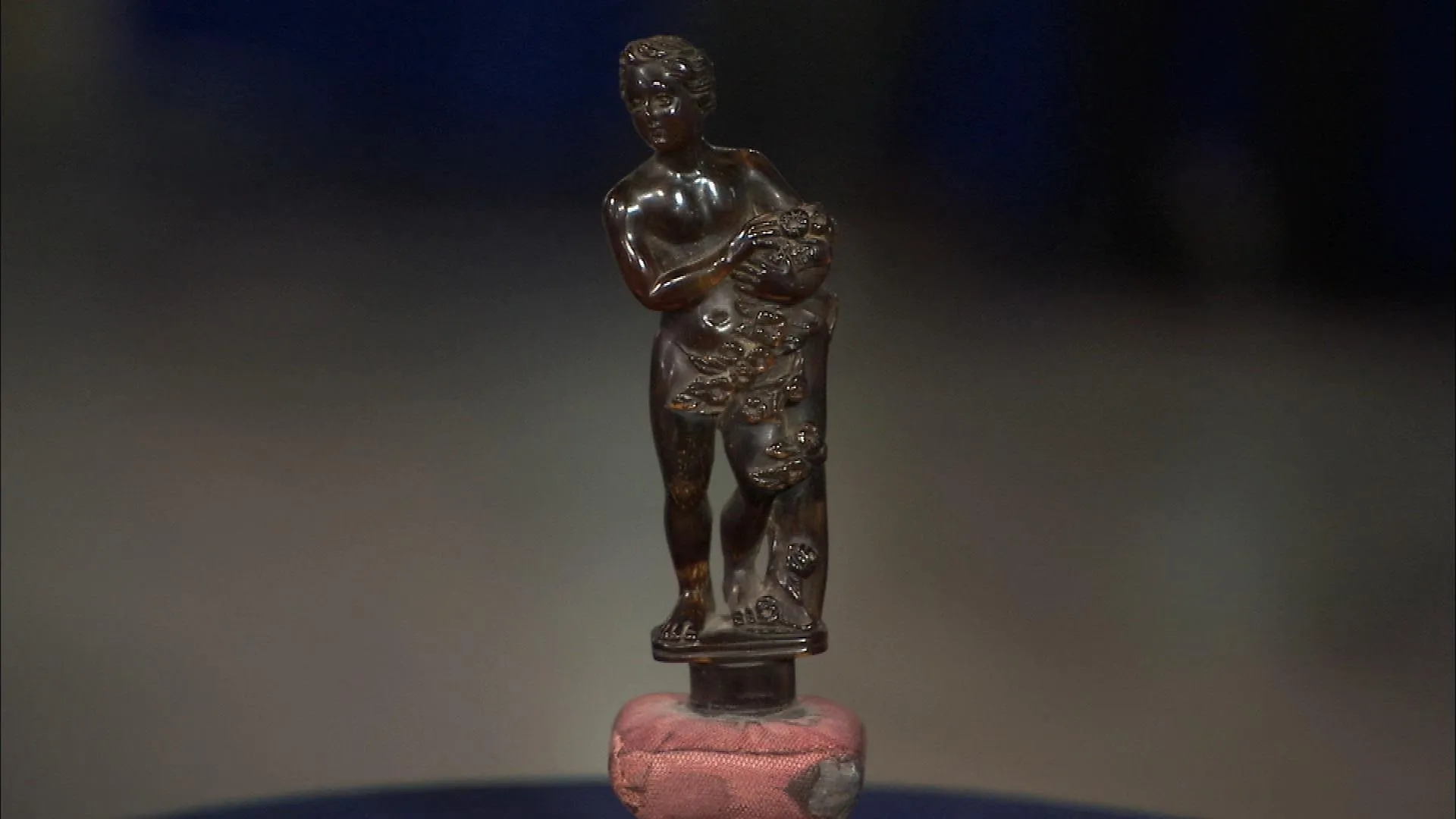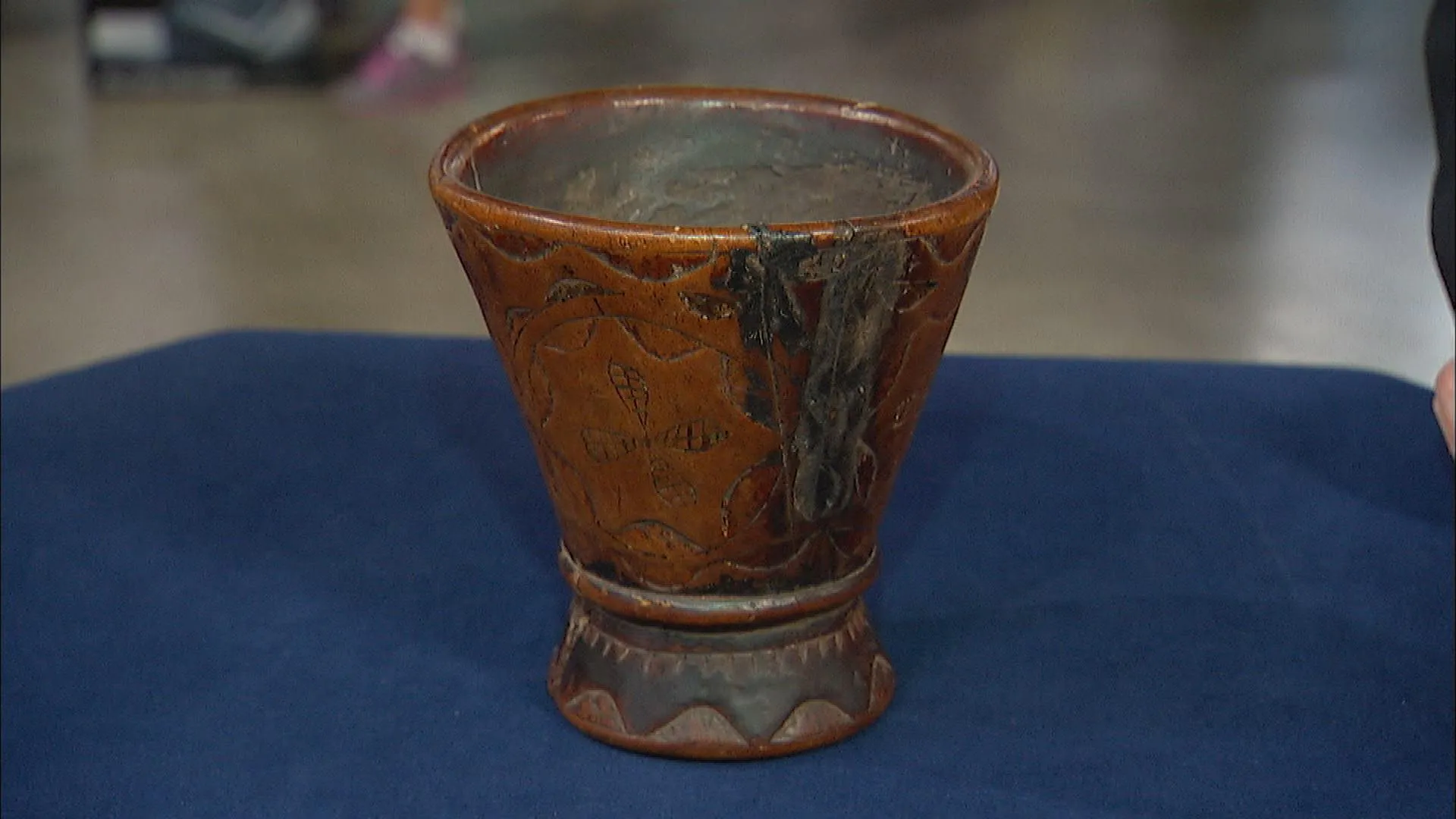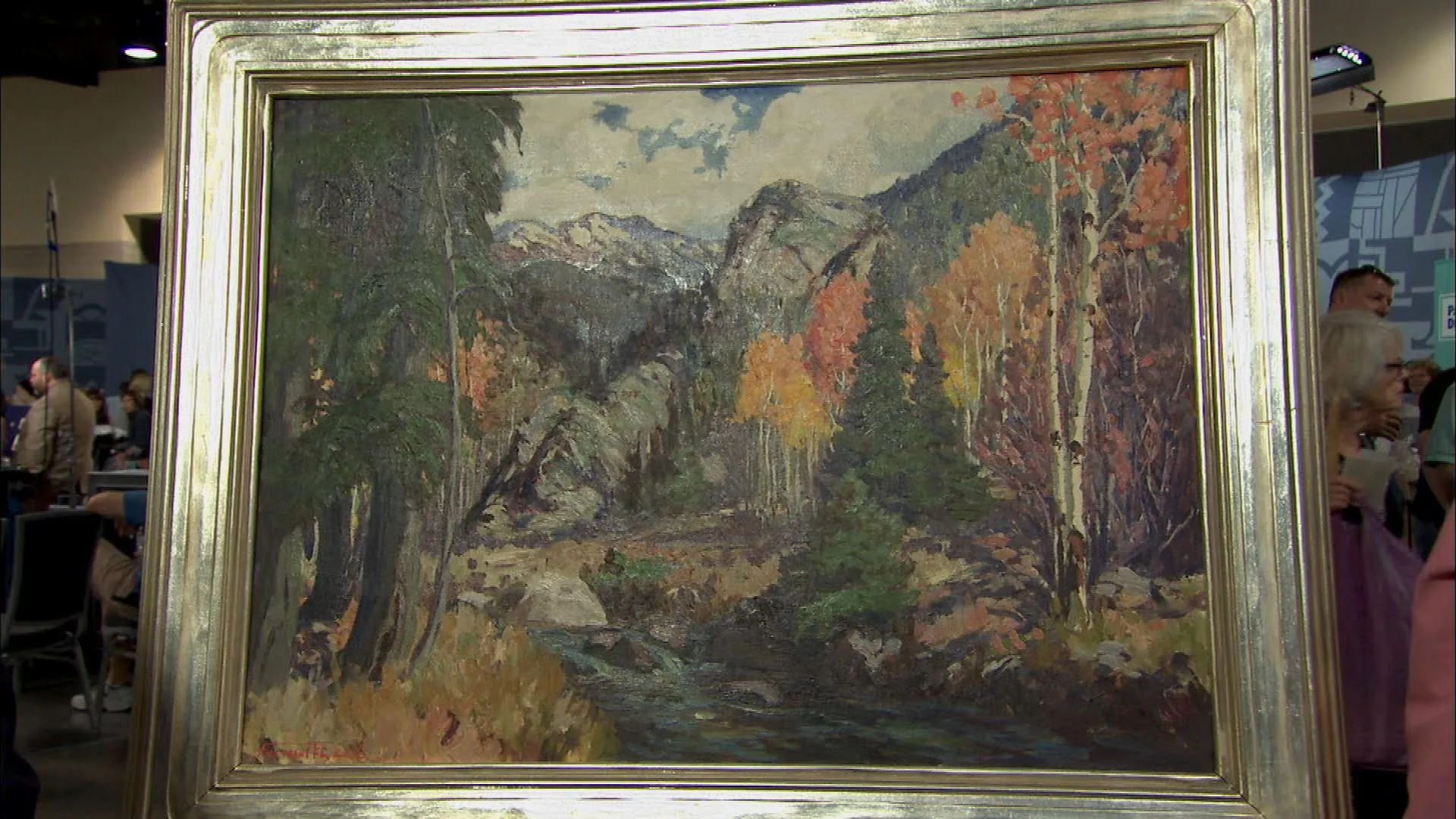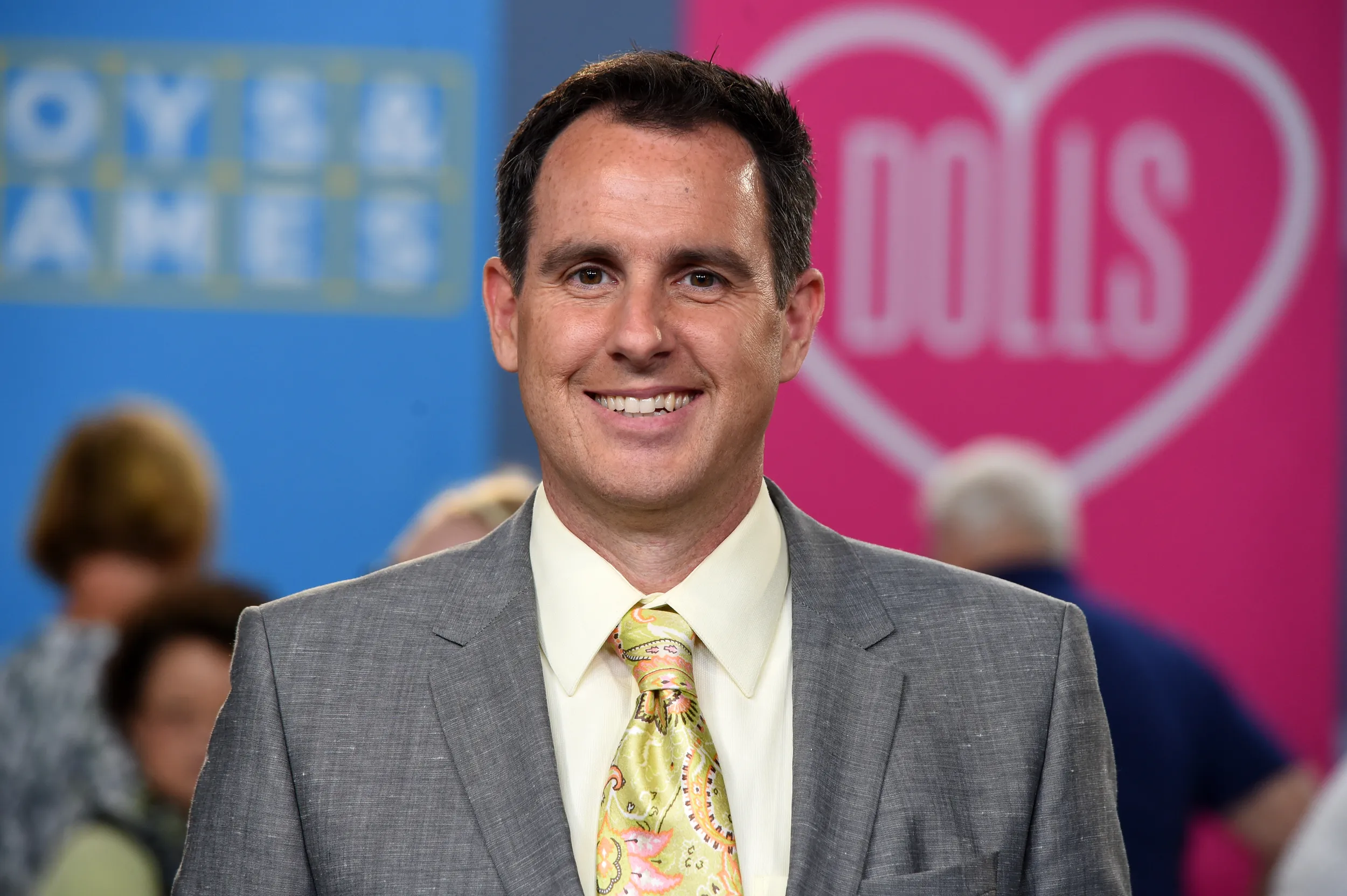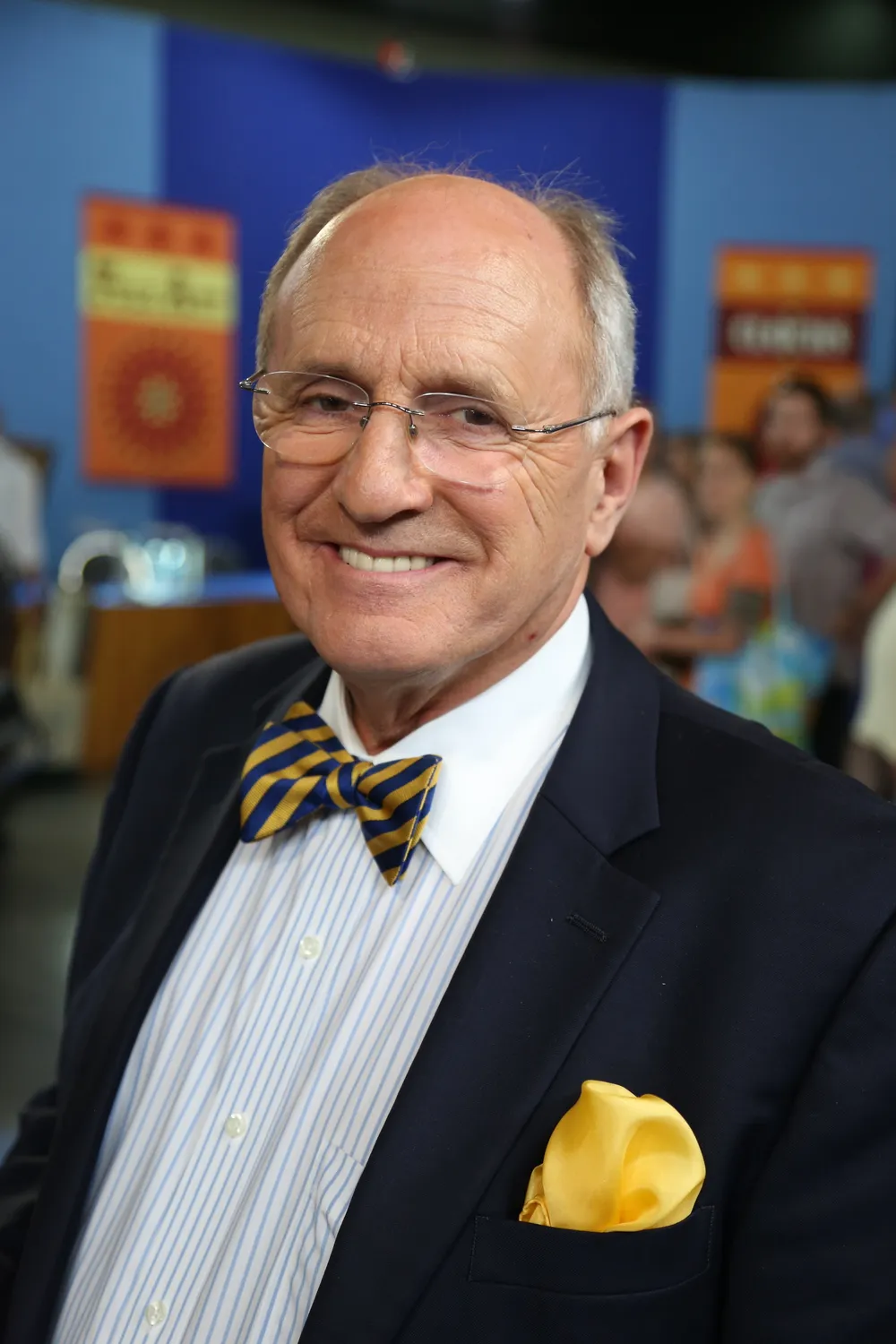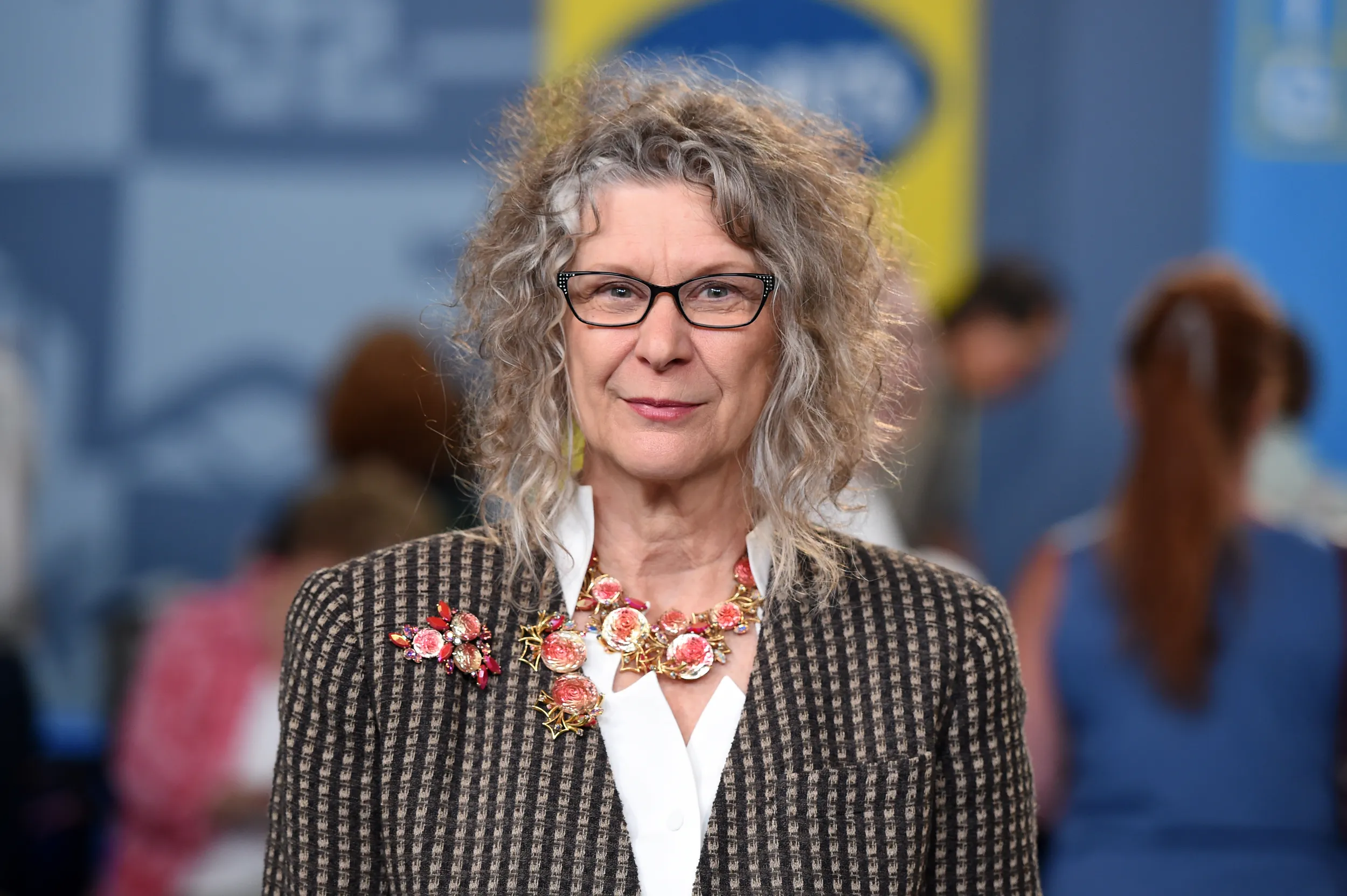HOST: From Spokane, Washington, it's Antiques Roadshow.
I've always just loved it. Especially as a child I loved to reach in and feel the melted cheese.
I don't know what to say.
(chuckles)
HOST: When Antiques Roadshow visited Spokane, Washington, we stopped at the Northwest Museum of Arts & Culture and saw some exquisite Plateau Indian flat-beaded bags. Back at the Roadshow event, more beautiful beadwork appeared in front of our cameras, this time created by Plains Indian artisans. We'll see those treasures later on in the show, but right now check out this heirloom by a well-traveled artist.
GUEST: It's been in our family for four generations. The woman that owned it and purchased it, I believe, was my mother's great-aunt, who lived back east.
APPRAISER: Now your mother's great-aunt, would she have been a well-traveled person?
GUEST: Yes.
APPRAISER: Maybe made a grand tour?
GUEST: Yes, yes.
APPRAISER: Through Europe and maybe North Africa, that sort of thing?
GUEST: Absolutely.
APPRAISER: Okay, that's the typical situation when a painting like this would make its way back to the States.
GUEST: Interesting.
APPRAISER: It's a very fine example of the Orientalist School is what we call it.
GUEST: Really?
APPRAISER: Which were North African, Middle Eastern subjects.
GUEST: Okay.
APPRAISER: The artist signed the oil, it's an oil on canvas. And his name is ThÈodore FrËre. There's also a plaque indicating the artist. And he was a French painter of the 19th century.
GUEST: Really?
APPRAISER: Born in 1814, died in the later part of the 19th century. And he was regarded as Neoclassical painter. A lot of his work was exhibited at the Paris Salon.
GUEST: Okay.
APPRAISER: But at that time, in the middle of the 19th century, Orientalist School subjects were all the rage. They were exotic subjects and so many French and European artists would travel to North Africa-- in this case, Cairo-- and they would paint the bazaars or they would paint the markets. Because people back home were insatiable for that kind of subject.
GUEST: Wow.
APPRAISER: In relation to FrËre's body of work, this is a top example for one of his Orientalist subjects. It's a large painting, approximately 30 by 30. It has probably its original gilt and gesso frame, and it's in a remarkably clean state. I would imagine that your family took good care of it, kept it out of the light. They probably had it cleaned once or twice during its lifetime.
GUEST: I have no idea.
APPRAISER: It's in wonderful condition. (laughs) I tapped it earlier, it's not lined, and it hasn't been tampered with other than being cleaned. Probably dates to the 1850s or '60s.
GUEST: That's what I was really wanting to pinpoint.
APPRAISER: This little flake here that you see on the canvas is the only condition issue that I see. And it's not difficult for that to be remedied by a conservator. It would require a little bit of overpainting, and that's all.
GUEST: Okay, okay.
APPRAISER: Overall, the canvas is in really pristine condition considering its age. On the marketplace today, for an auction value, this painting would probably fall in the top tier of FrËre's works, and conservatively today I would easily expect in the region of $20,000 to $30,000.
GUEST: Oh, my Lord! Does that mean I have to get it insured? (laughs)
APPRAISER: You might want to do that. Thanks for bringing it.
GUEST: Wow, I'm just blown away.
APPRAISER: Thanks a lot.
GUEST: Thank you!
APPRAISER: You brought in, obviously, a Tarzan book.
GUEST: Yes.
APPRAISER: Tell me about it. Where did you find it?
GUEST: It was just an estate sale and I just liked it, so I bought it. I liked the cover, and it's interesting. I like books, so.
APPRAISER: Do you read Tarzan in general or just...
GUEST: (laughing) No. I have grandchildren, so I just picked it up on a whim.
APPRAISER: When did you buy it?
GUEST: I'm not sure, I'm thinking 2000?
APPRAISER: About 15 years ago?
GUEST: Yeah, yeah. You know, I think it's one of the early ones.
APPRAISER: This book is done by a company called McClurg.
GUEST: Okay.
APPRAISER: Who are actually the first publishers of the book. There was a reprint company called Grosset & Dunlap that did later printings of them. They did them very nicely. They actually can have some value because they also have very pretty dust jackets. And then there was a Burroughs publishing company, because after he started publishing, getting popular, he said, "Why do I have to pay a publisher? I'll have my own publishing company."
GUEST: Oh, he did.
APPRAISER: And so some of his later books are done by Burroughs Publishing, but let me show the title page here.
GUEST: Okay.
APPRAISER: It's Tarzan the Untamed. It was done in 1920, McClurg & Co. When you flip over the title page, it's 1920-- the copyright. So this is the first edition of this book.
GUEST: Oh, good.
APPRAISER: And one of the important parts about first editions is the dust jackets. Collectors who collect this kind of book, the jacket is almost everything. And one of the reasons for that is if you think about it, you get a book, it's well-read, people enjoy it...
GUEST: Sure.
APPRAISER: What falls apart first, what goes away first?
GUEST: Right.
APPRAISER: Sometimes what do people take off first? And the other thing about this is the first Tarzan book, which everybody knows, that was done in 1914. And one of the things that's sometimes very helpful if you're wondering where in the series this comes, well, you can open the dust jacket.
GUEST: Ah!
APPRAISER: And it very conveniently shows you that there were six before this, and this is the seventh in the series out of 24 that he did total on the Tarzan series. It's in good condition. There are a few little tiny nicks and tears, not the worst thing in the world. Now, you said you bought it at an estate or yard sale.
GUEST: Yeah
APPRAISER: Usually books aren't priced that high. Do you remember?
GUEST: You know, I think I just handed her a dollar.
APPRAISER: And she handed you the book.
GUEST: (laughing) Right.
APPRAISER: This book, an average, good retail value is $1,500.
GUEST: (laughing) Really?
APPRAISER: Really.
GUEST: Cute. (laughs) I like it.
APPRAISER: If you didn't have the dust jacket on this, maybe $100, maybe $75.
GUEST: Oh, really?
APPRAISER: Because the collectors who want it, they want that jacket. Even when you first said at the beginning, "Oh, it was colorful, it caught my eye."
GUEST: Right.
APPRAISER: It's the dust jacket. It's the dust jacket that caught your eye.
GUEST: Great.
GUEST: This was my uncle's mother's watch, and I inherited it, and it was stored away for the last 14 years. Just before the Roadshow, I said, "I wonder what's in that box," and we picked this out, and there was actually four watches. This is the one that I picked.
APPRAISER: This watch was made during the middle of the 18th century, and it would have been a French maker. The watch itself is made of gold, and the stones that you have around it, those are not diamonds, but actually colorless sapphires.
GUEST: Really?
APPRAISER: What you would have powering this watch is a mechanical movement, they call it a fusee movement. This is a chain-driven watch. It's really a neat piece of mechanics that you have here.
GUEST: Wow.
APPRAISER: In auction, an item like this would sell for around $1,500 to $2,000, estimate. What you have here, though, is you have a little bit of something extra. You have this key that with these types of watches, you never see them, they're always lost. It has a nice piece of quartz in it. The key itself adds about $500 to your item.
GUEST: Wow.
APPRAISER: So auction estimate, you would really have $2,000 to $2,500 altogether.
GUEST: Wow, that's great.
GUEST: My grandparents lived in Lewiston, Idaho, and worked at a bakery there. And somehow they ended up with this, and they were working there about the 1930s, maybe early '40s. It got handed down through my mother to me, and my mother actually has the duplicate, the exact same canvas in her possession, and so that's how I ended up with it.
APPRAISER: It's a great visual piece. I mean when it was unrolled and I looked at it, just the colors pop off of it. And when you said that your mother has it on canvas, what I wanted to point out is this is actually not a poster. It looks as though from a distance as though it's paper that's been linen-backed, but this is actually printed on the linen canvas, so it's a little bit different than how we're used to seeing posters and things like that that were made for films. And this is obviously not exactly a film poster. It's promotional in conjunction with the film. And when you said that they were at the bakery in the '30s, that makes perfect sense because Snow White came out in 1938. And what this illustrates is probably one of the greatest merchandising and licensing companies in the history of the world, which is Disney. And following the Mickey Mouse Club, they decided that having clubs for kids was probably a good idea promotionally. And what we see here is they're advertising Snow White Bread, but they're also advertising the Jingle Club, which was something for children. If they wanted to join they'd get that button and the little book that you see over there. It was trying to tie in to a lot of the serial promotional items that a lot of the comic strips were doing. Superman's in the same era. You had a lot of promotional items like the rings and things like that. So it was Disney's way of trying to get into that same market and get kids interested and excited about the movie. I don't think they really had to try too hard. Being Snow White, it obviously was a huge sensation, but it was a way to make kids feel really involved with the production, and like a special member of a club. And there is a little bit of writing over here.
GUEST: And I don't know what that is.
APPRAISER: It looks like somebody just decided to write on it.
GUEST: Yeah.
APPRAISER: From my eye, it actually looks like pencil, it looks like graphite. It'd be really easy for someone to remove and you could have it easily restored. You don't really need to do anything to the color. I mean the color just pops off of this thing, which is amazing. But up until 1991, I don't think a lot of collectors had seen this. And then in 1991 there were ten of these found in a warehouse somewhere in Ohio, and they came out, and we don't think they were ever used. They were in perfect condition. One of those that we could find record of that sold publicly was in 2001, and it sold for $6,500. Which brings us to, what does that mean for today? That was 14 years ago. So in today's market, we think every bit of at least $8,000 to $10,000, but who knows, a lot of time has passed. So if there are a lot of collectors out there who have wanted to get their hands on one, and have been waiting for 14 years to see another one come up, it very well could do better than that.
GUEST: Wow. (laughs) I didn't expect that. Thank you.
GUEST: I inherited it from my parents. I just sit it on a table top and look at it and feel it once in a while because I love the inside of it. Have ever since I was a child.
APPRAISER: It's made by a man named Glen Lukens, and Glen Lukens was an incredible innovator in ceramics. In the 1940s and '50s, American studio ceramics production was almost under attack by a new young generation of innovative thinkers. And in Southern California, Glen Lukens was leading the charge. He was a teacher at USC.
GUEST: My father was a color photography teacher at USC.
APPRAISER: Aha.
GUEST: Aha.
APPRAISER: Aha. So he would have known Glen Lukens.
GUEST: I'm sure.
APPRAISER: A fellow professor at USC.
GUEST: That is very possible.
APPRAISER: Glen Lukens was extremely well known and well liked. Everyone on the campus-- all the professors, all the teachers, his classes were incredibly popular. He was much more influential than just a ceramics teacher. Among his innovations was making ceramics in molds and letting the raw body of the clay stay exposed. And using glaze not in a traditional manner, but he was almost painting with the glaze and making modern statements with it.
GUEST: Yes.
APPRAISER: And because he did that, he influenced an entire generation of artists. So he had a very wide range of styles. Today, collectors really like this style. This is what they're looking for, they're looking for this raw body here with raw clay, and they're looking for this very colorful glaze. This glaze is applied in a way that no one was using glaze previously. It almost looks like melted cheese.
GUEST: (laughing) Yes, yes, it does.
APPRAISER: Well, that's a funny way to decorate a clay body, isn't it? But today it's very highly prized by collectors. It's signed on the bottom here, in typical fashion, "Glen Lukens." So this would have been made probably in the very late '30s or all throughout the 1940s. That's when the production of this thick body of clay was most popular in his work. Have you ever thought of how much it might be worth?
GUEST: I haven't the faintest idea. I've always just loved it, especially as a child I loved to reach in and feel the melted cheese. I have no idea, it just occurred to me last night to bring it to the Roadshow.
APPRAISER: Well, I can tell you that in today's market, I would appraise this for $5,000 at auction.
GUEST: Really. Oh, my gosh, that's exciting and completely unexpected. Completely.
APPRAISER: You brought in this very large watercolor by Percy Gray. Where do you have this hanging in your home?
GUEST: I have it over an antique desk.
APPRAISER: Is it in the light at all?
GUEST: No.
APPRAISER: Now where was it before?
GUEST: It was by my dad's front door. I don't think it got any natural light either.
APPRAISER: So you inherited this piece?
GUEST: Yes.
APPRAISER: And what do you know about Percy Gray?
GUEST: I know he loved the California landscape and painting eucalyptus trees.
APPRAISER: Okay, well, Percy Gray is correct, a California painter, he was born in San Francisco in 1869 and he lived out there pretty much. Did some work as an illustrator in New York in the early part of the century, then came out and did a lot of the natural landscape of California-- particularly the eucalyptus trees and the oaks and the cypress out there. This is one of the largest ones you could possibly have.
GUEST: Oh, really?
APPRAISER: In the world of watercolors, we have something called a full sheet. And a full sheet is about 30 by 22 inches. Now often you'll have things that are cut in half or quarters, and 14 by 11 or something, 15 by 11. But this is almost 30 inches and about 22 wide, so you couldn't get a much larger Percy Gray watercolor.
GUEST: Oh.
APPRAISER: The other thing is I asked where you had it because it's in very good condition.
GUEST: Good.
APPRAISER: Every watercolor's faded some, but some more than others. But one of the things to know a good one is to see the colors, the richness of the colors you see in the greens here, but also these blues that you get here. Blue is one of the most highly fugitive colors and it frequently goes away. So you get these blues all the way down through here. It's signed down here "Percy Gray, 1932." So we know at that time he had a studio in Monterey, so it was probably done in the northern central coast area. Did you have it framed or you had your father...
GUEST: No, no, I think my grandfather framed it.
APPRAISER: Well, maybe a little bit after because this is frosted glass.
GUEST: Okay, okay.
APPRAISER: It may have happened in the '60s or '70s.
GUEST: Ah, sounds right.
APPRAISER: And I don't like the frosted glass. You can't really see it as well, do you notice that? I would recommend maybe switching that out, going to a framer and getting ultraviolet- filtered Plexiglas.
GUEST: Oh, really?
APPRAISER: Which would keep the ultraviolet light out and keep it in better shape. Also if it falls off the wall…
GUEST: Right.
APPRAISER: It doesn't break.
GUEST: Right.
APPRAISER: If this breaks, then the glass can cut the image. Now have you ever had it appraised?
GUEST: No.
APPRAISER: Right now, we'd probably put an auction estimate of $25,000 to $35,000 on it.
GUEST: Oh, my. Oh, that's great. I've always loved this piece, so it's nice to know it's worth so much.
APPRAISER: And what's tricky is trying to figure out what this kind of thing is for.
GUEST: I mean it really is a challenge because...
GUEST: Hi. Hi.
GUEST: This is a first edition of Sherman Alexie, well-known writer across the Northwest, but we're very proud because he's from Spokane and of the native Spokane tribal members. He was hired in my office as a secretary for me in 1991, '92. He was a skinny, quiet and a very shy guy. He barely even told us he was a writer, but during the time that he was at our office he got his first major book contract, and I was able to have this book inscribed by him. He was an excellent employee, very funny and witty and very good with words.
APPRAISER: The Business of Fancy Dancing is his first published volume of poetry. Not only do you have a first edition, you have a warmly personally inscribed copy to you in the year of publication. I'd like to read it if you don't mind. "For Paul, here we are at the edge of the 21st century, and this Indian boy is still singing and his voice is only one growing large and beautiful. Listen, for 500 years we've been heavily underrated. In beauty, Sherman, March 10, 1992."
GUEST: Those are some powerful words.
APPRAISER: He was a... he was and is a powerful writer, he's one of our best Native American writers living in this country today. At his readings and signing, they're performances. He's largely performing for white audiences and he loves to get under people's skin and make them uncomfortable. But he does it with humor. The ubiquitous trade paperback doesn't have a lot of value per se, but this copy was one of only 100 copies issued in hardbound.
GUEST: I did not know that.
APPRAISER: It's also important because it's the beginning of his career. It's a warmly inscribed first edition of his first book. At retail, this book would bring $3,000.
GUEST: Oh, my gosh.
GUEST: It's been in my family. My great-aunt owned it, and she lived in Palm Springs, L.A. area. What I'd been told about it is that her daughter was ill and in the hospital, and that her doctor gave her this photograph as a gift. And then I was at a floral shop and I saw some greeting cards, and I saw the image on a greeting card. So I bought the greeting card, took it home, and looked at the back of the greeting card and it mentioned a gallery. On the Internet I found a book that was pictures from the showing that was at the gallery, and this photograph was in the book.
APPRAISER: And it's actually on the cover of the book.
GUEST: Yes.
APPRAISER: So the name of the photographer is Dain Tasker. He was a physician, a radiologist at the Wilshire Hospital in Los Angeles. And like many professional men of the early 20th century, he became interested in photography in the 1920s. And so here he is in his day job using x-rays and he has a kind of aha moment-- that I'm going to look at flowers as the subject matter, as the content of my pictures. He'd already been photographing for about ten years. And so the x-ray becomes his art form.
GUEST: Mm-hmm.
APPRAISER: Apparently, Dr. Tasker enjoyed gifting his photographs to nurses, to patients, to other physicians. And then he met a photographer in L.A. whose name was Will Connell, and Will Connell was 25 years younger than Tasker, very prominent fine art photographer, and he encourages the doctor to look at his work more seriously. And he crosses over from being an amateur photographer to a professional photographer.
GUEST: Mhmm.
APPRAISER: At today's Roadshow, I've seen many other examples of x-rays of flowers.
GUEST: Really?
APPRAISER: By photographers who apparently were local photographers, but who didn't have gallery exposure and who didn't have their work reproduced in magazines and seen in salons. So the value of their pictures would be a few hundred dollars. At auction today, a preliminary estimate for this photograph would be $6,000 to $9,000.
GUEST: Wow, that's great.
GUEST: I know absolutely nothing about any of them except for the ball. The ball was a gift from my grandmother. I was born on an Indian reservation in eastern Montana. My family received one when a child is born, and so I was given mine I think-- well, I'm 53, so probably at least 50 years ago.
APPRAISER: And the other pieces, how did you get those?
GUEST: I bought them at an auction and there was a large collection of them that I bought, and I just... I don't know anything about them. I liked them and at the time it was kind of a whim, and just decided to go for it.
APPRAISER: And how much did you pay at that auction for these moccasins and the bonnet?
GUEST: I'm not exactly sure how much, because it was a much larger collection. I think it was $5,000? I bought them in, I think, 1998.
APPRAISER: Did you grow up around beadworking?
GUEST: Well, we saw it a lot. You know, they have the different tribal ceremonies and whatnot, and I always thought that was beautiful, so.
APPRAISER: So did you go to the grass dances in the summer and all that?
GUEST: We did all of it, yes, I did spend my summers in Froid, Montana, where my grandmother lived.
APPRAISER: So are you Oglala or...
GUEST: (laughing) Well, I'd like to say I am, but the tribe when I was born had just stopped the roll books, so I have a brother and sister that are registered Native American, and my sister and I-- my younger sister-- are not. (laughs) So it's a very strange situation.
APPRAISER: That's really interesting. The two pairs of moccasins and the little baby bonnet, they're Lakota.
GUEST: Oh, okay.
APPRAISER: So they're from east of the Oglala people.
GUEST: So maybe more the Rosebud reservation.
APPRAISER: Yeah.
GUEST: My husband is actually from that.
APPRAISER: Oh, really?
GUEST: Yeah, that's where his mother was born.
APPRAISER: So this is very connected.
GUEST: Yeah.
APPRAISER: This is all beadwork that was made between about 1890 and 1910.
GUEST: Okay.
APPRAISER: This is typical of that area. This is silk ribbon and it's starting to shatter.
GUEST: Right.
APPRAISER: There's not a lot you can do about it. These are a little unusual in that they're beaded on the bottom.
GUEST: Yeah, I was wondering about that. I kind of figured they were ceremonial of some sort or...
APPRAISER: Ceremonial's good. They call them burial moccasins.
GUEST: Oh!
APPRAISER: But they're not.
GUEST: (laughing) Oh, okay.
APPRAISER: From what I know of what really got it started was when a young man would get married, he was the show.
GUEST: Okay.
APPRAISER: And he would be carried in by all his buddies on a big buffalo robe or on a blanket. And they would make these moccasins that were beaded on the bottom.
GUEST: Oh.
APPRAISER: What really interested me about this is it's got a little animal fetish. It's probably a lizard or a turtle on the bottom of this.
GUEST: I have no idea what it...
APPRAISER: And while the Sioux were great about making little umbilical charms.
GUEST: Okay.
APPRAISER: That were usually in the form of a turtle or a lizard.
GUEST: Oh.
APPRAISER: And so it's neat that this ball made for your birth would have the same symbol on the bottom. In the old days, they were stuffed with buffalo hair. And I don't think this one is. I can't imagine it. I think it's something else. As far as value, the moccasins, these are worth $800 to $1,200.
GUEST: Oh, okay.
APPRAISER: These are worth $1,400 to $1,600.
GUEST: Oh, very nice.
APPRAISER: This is probably worth $800 to $1,200.
GUEST: Mm-hmm.
APPRAISER: So $2,400 for these pieces, $3,400, $4,000 and probably $400 to $600 for this.
GUEST: (laughing) Oh, seriously.
APPRAISER: Yeah.
GUEST: Really?
APPRAISER: Yeah.
GUEST: (laughing) I would've thought it had no value.
APPRAISER: Yeah, no, $400 to $600.
GUEST: Oh, wow, oh, very exciting.
APPRAISER: Especially it's so beautiful. That's in an auction, that's not in a shop.
GUEST: I love it. Like I said, my... it's sitting out on a shelf.
APPRAISER: Well, it's family stuff, and you can't put a value on that.
GUEST: Right, no.
GUEST: My uncle owned a pawn shop for years and then he closed down the pawn shop, so he had it in his home, and then when he passed away he left it for me and hadn't told me anything about it other than a sticker on the back that said it was a 1890 JJ Audubon lithograph.
APPRAISER: Now, I have to say, I'm not sure so far you've had proper appreciation. Can you tell me where it's been since you got it?
GUEST: (laughing) Well, it didn't go with my decor, so I put it in a closet and threw a blanket over it and it was in the back of the closet for probably the last 13 years.
APPRAISER: Whether it goes with your décor or not, it is certainly a dramatic print.
GUEST: It is.
APPRAISER: And it is by John James Audubon, and it really represents what makes John James Audubon famous and one of the best American natural history artists. The birds are done life-size, and it's got the color and the drama and the impact that just jumps out at you.
GUEST: It does.
APPRAISER: Now, Audubon did these life-sized bird prints first between 1826 and 1838. And they were done in London as hand-colored aquatints. Audubon died in 1851 and his son, John Woodhouse Audubon, decided he would try to reissue it. But instead of doing aquatints in London, he decided he would do the new process-- or relatively new process—of chromolithography. And chromolithography is where every color is printed with a separate stone. And this is one of the earliest, really large projects done. It was done by a New York chromolithographer named Julius Bien. And actually it's not 1890, it's 1860.
GUEST: Oh.
APPRAISER: Because these prints were done between 1858 and 1860.
GUEST: Okay.
APPRAISER: Now, one of the nice things is of the Audubon's large prints that are life-size, the Havells, which are the first editions, are often reproduced. So if you have a large one that says Havell, it might be a reproduction.
GUEST: Oh.
APPRAISER: If you have one that says Bien, you know it's an original.
GUEST: Okay.
APPRAISER: Now, what was interesting is these were sold by subscription, which meant that people would buy a few of them from them, they give them the money, they use that money to make some more, and then they buy them, and that's the way that they raised the money.
GUEST: Oh.
APPRAISER: Well, Civil War came along. A lot of the subscribers to this series were Southern. They decided to stop buying them. They weren't going to send money up to New York for this. They didn't have the money, they had the war coming, and this actually is quite rare because they only did 105 plates versus the 400-plus plates of the first edition.
APPRAISER: Oh.
GUEST: And of each one, they think only between about 100 and maybe 150 of each individual prints. So they're actually quite a bit rarer than the first editions.
GUEST: Wow.
APPRAISER: Now, the first editions, because they are first editions, do sell more, but these could have surprising value. This print, even in this condition, would sell in a retail value for probably about $3,000 to $4,000.
GUEST: Wow.
APPRAISER: And the reason for that is because it is one of the great images, and it could be fixed up. It has some water stains, you can see there's some stains down here, and you can see along here you've got where the glass probably broke at one stage and it kind of damaged the paper?
GUEST: Right.
APPRAISER: Now, that can be fixed up.
GUEST: Okay.
APPRAISER: It would probably cost about $1,500 to fix it up, but if you did that, you could have a print that's, with the frame, that's worth maybe $7,500 to $8,000.
GUEST: Wow, wow, wow. Well, thank you, oh, my gosh. Oh, wow, that's awesome, not what I expected.
APPRAISER: Good luck.
APPRAISER: Well, a couple of things right off the bat. This thing wouldn't hold much water.
GUEST: Not anymore.
APPRAISER: Do you know where it's from at all?
GUEST: My son-in-law and my daughter gave it to me because I love it.
APPRAISER: I don't know if the family has any Austrian connection, do you think?
GUEST: I don't think so.
APPRAISER: Okay. This was made in Austria in about 1900 at the Amphora Porcelain Works. But when you see the name Amphora, you look for this kind of design-- these beautiful Art Nouveau women-- but this one has a little extra. First of all, it has this beautiful sun here, exquisitely done, and I've not really seen that before, and that certainly gives it more interest to a collector and more value. And these little jewels, these aren't actual jewels, they're bits of hard stone from the nearby region. They're not precious gems, but they really elevate the whole thing and they're an unusual feature. I'd certainly estimate it at auction between $1,200 and $1,600.
GUEST: Well, that's wonderful.
GUEST: It's been in the family for years. I'm 70 years old, so it's older than that because I remember as a kid walking on it. It was my grandparents', who gave it to my uncle, and it was the one thing I really wanted and my cousin gave it to me. And I love it. I know it's Indian.
APPRAISER: Well, actually it's not an Indian rug.
GUEST: (laughing): Oh, okay, well, that tells you how much I know.
APPRAISER: This is a rug that was woven in Persia.
GUEST: Oh, really?
APPRAISER: And it's a tribal rug.
GUEST: Oh, neat, even better. Even better. I mean even better for me because I love oriental rugs.
APPRAISER: Oh, okay, well, it falls into that category, but what's interesting, it's a cottage industry rug that was made for the marketplace by nomads who were trying to capture part of the marketplace.
GUEST: Oh, okay.
APPRAISER: And what I love about it, and what I love about these rugs in general is that they're very primitive and naive. And the women that were making them were left to their own devices because these were not expensive rugs in their day, and they could be creative. So in the case of this rug, there's a wonderful camel that's depicted right here.
GUEST: Oh, I see it.
APPRAISER: With a little person on top of the camel. And then in the border you have all these human figures.
GUEST: Wow, yeah.
APPRAISER: Through the border, all the way up and down. So the reason that these rugs are very geometric is because they are coarsely woven.
GUEST: Mm-hmm, mm-hmm.
APPRAISER: And so even though they might like to do a realistic interpretation of a tree or a flower, it's like pixels on a computer. There's so few knots per square inch that everything ends up being geometric. It has a great range of natural dyes and there's just a real exuberance to the design and a primitive quality that is more apropos to today's market than the more fancy rugs you might be familiar with. There's this amazing macramé end finish that is done in undyed brown wool.
GUEST: Right.
APPRAISER: And this is yet another indication of the fact that they were a small production that had enough brown sheep on hand that they could come up with that amount of wool for their warp threads. Now, one of the things that helps us date a piece like this is the dyes. And the majority of these dyes are natural dyes, but there's one synthetic dye that dates back to the 19th century, and it's called fuchsine. There's a aspect to the dye where if you fold the pile back, and if you look at the root of the knot?
GUEST: Yeah.
APPRAISER: Do you see how it's purple?
GUEST: Yeah!
APPRAISER: So this dye was introduced in the 1860s, and it faded from a purple to a beige.
GUEST: Oh, so these used to be purple.
APPRAISER: That used to be bright purple.
GUEST: Wow.
APPRAISER: And that actually is an assist to our dating the rug because if this rug were 60 or 70 years old, that dye wasn't even in use anymore.
GUEST: Oh, really, so it's really old.
APPRAISER: Yeah, so this is about a 1900 rug.
GUEST: Right, wow.
APPRAISER: Well it's in strikingly good condition for its age. Now in terms of value, I would say that in today's market, if you had to go out and buy a rug like this, you'd have to pay about $4,000 retail.
GUEST: I'm... I'm sure. (laughing) I... I buy oriental rugs, I got it.
APPRAISER: Yeah, so you have a newfound appreciation for the rug.
GUEST: Absolutely.
GUEST: This is my godmother, who kind of adopted me after my mom passed away. And she was part... a set of twins who performed in the early '20s, '30s, '40s playing accordion, steel guitar, all sorts of things and singing with her twin. And then she also performed for the Allied troops over in Europe, in Germany and Austria. And her husband was a Shriner, so she would play and sing and entertain children at the children's hospital, as well as troop hospitals for injured people. And I inherited her costume jewelry that she performed in.
APPRAISER: This jewelry is pretty fabulous stuff.
GUEST: Yeah.
APPRAISER: This is her and we're actually showing her wearing it. I would say this picture dates from probably late '40s-- mid to late '40s.
GUEST: Yes.
APPRAISER: And the piece we have here, when we have three or more pieces to a set, it's called a parure-- that's a French term. So you have a parure of costume jewelry. Now, what intrigued me about this piece is I am not sure who made this piece.
GUEST: Okay.
APPRAISER: But I have my suspicions. There was a designer in New York City named Miriam Haskell. And she did not sign every piece she did.
GUEST: Ahh.
APPRAISER: But she created pieces like this, so it's in my gut. I'm feeling that this is an unsigned parure by Miriam Haskell. Miriam Haskell used rose montee, and that's these little rhinestones here. They're flat on the back and they're prong-set.
GUEST: Yes.
APPRAISER: She also used a type of gold color. It's not real gold, it's called Russian gold. And it's not real shiny, but it has a depth of color that is amazing. She also traveled all over the world collecting unusual beads, and she's used an aquamarine-colored bead and contrast it nicely with a yellow-colored bead. Now the cool thing about Haskell is all of these pieces are handwired on. All that wire work is covered up on the back with fantastic filigree.
GUEST: It's beautiful.
APPRAISER: It is beautiful, and it makes it actually smooth against the skin and it won't snag on your clothing either.
GUEST: Ah.
APPRAISER: The bracelet is made of memory wire inside, so there's no clasp. It just kind of clasps on your wrist, which is a nice thing because it fits a small wrist and a large wrist.
GUEST: And it's very flexible still, which surprised me.
APPRAISER: Very flexible. Now an unsigned Haskell... in 2015, on today's market, Haskell is very hot, very hot, especially with the colored beads that we see here because mostly she did pearls and gold beads and gold chain. Sometimes she would do special sets for people and she might have even created this for your godmother. On today's market, retail level, this set could sell for $1,200 to $1,500.
GUEST: Really?
APPRAISER: Yes. And if we could prove that it is truly a Haskell...
GUEST: Uh-huh?
APPRAISER:...it could go up to $2,000 for the set.
GUEST: Oh, my gosh! For costume jewelry. But I know it's beautiful, I love it. Thank you so much.
APPRAISER: Appreciate it, it was a pleasure.
GUEST: And I'm sure my godmother is going, "Yes!" (laughs)
GUEST: This is my great-great-grandfather's Civil War hat. It's been handed down through the family. And I wanted to bring it in to get some more information about it.
APPRAISER: This is what's called a model 1851 Shako, and they were used till the later part of the 1850s. They're very rare, there's not that many that survive anymore. It was actually pre-Civil War, and later on they changed styles of cap. They took the stiffener out and the top crown here flopped down towards the visor. So it was a lot more comfortable cap. This particular cap has the insignia here, with a wreath and an "NJ" for New Jersey. It's got a painted leather chin strap, and if we look on the side, we've got general service buttons here for an officer. If we turn it back around and take a look on the inside, you can see it's got its sweatband in tact, which is extremely rare, and there's a silk liner. Silk normally would not survive this long. It's a little bit tattered, but it's still in place. Inside is also Smith Young & Company in New York City. It also has its original pasteboard box with the name and the maker here. Now, as far as taking care of it, I would not keep it in the box. I would take the newspaper out and I would put this in an acid-free box with acid-free paper and keep the two separate. Because if you keep the newspaper and everything else in there, it's eventually going to eat away at the lining and destroy the rest of the cap, which we don't want to do. Having the two together is fairly rare. It's rare enough that this cap even exists the way it does. But with the box, it's going to add a little bit of value to it. In an auction setting, this cap would probably be in the $3,000 to $5,000 range. It's in great condition.
GUEST: Great, great. Thank you.
APPRAISER: You're welcome.
GUEST: Well, in 1962 I lived with Chuck Close, and at the end of the summer when he was downsizing, came into possession of this piece, and with very few exceptions, it's been hanging on a wall of mine ever since.
APPRAISER: Wonderful, so it came right from the artist to you, that's a wonderful provenance for a piece.
GUEST: Yes.
APPRAISER: The piece is dated 1961, so very early in Chuck Close's career. He was born in 1940, so probably only 20 or 21 at the time.
GUEST: Yes.
APPRAISER: And of course, this is not necessarily what you think of when you think of a Chuck Close. You think of these large-scale portrait heads, photorealism, very far from this abstract expressionist-inspired work. So it's a particularly interesting and rare example. This is an oil on canvas. He called it "The Turkey Painting"?
GUEST: Yes.
APPRAISER: I see there's a little bit of... of damage here, puncture holes, but they're small and they're not in the main section of the canvas. At auction, I would put a value of $50,000 to $80,000 on this painting. It could conceivably go for even more.
GUEST: That's... I don't have any plans to sell it. That is nice.
GUEST: Well, I bought it in '64 and played in different bars and stuff with it. I had a little experience with it. My son took it to his place where he was living with some other kids and I found it was missing, so I called him and said, "You get that guitar and get it home." And the next day he called his mother and said, "Mom," he said, "that guitar has been stolen." So I had a picture of it—me playing it-- and so I took it in to this guy and asked him if he could appraise it. And he looked at me kind of funny a couple times and finally he said, "You know, I think I had your guitar in here a couple weeks ago." He said, "I bought it out of a hock shop in Coeur d'Alene." And he said, "I shipped it back east and I traded it for two Dobros." And I said, "Well, do you know the guy's name?" And he said, "Yeah, I've got his name and phone number." And so I went to the police station and talked to them, and the policeman told me he said he will send that back. And he said, "He's dealing in stolen goods." And so the guy finally called me and he said, "Well, if you pay the shipping and handling on the shipping it over here and shipping it back," he said, "I'll send it back to you." And I said, "Okay." Well, I knew the kid through checking with the hock shops and stuff, so I went and talked to him and his dad, and I told his dad. I said, "If you pay for the shipping and the handling, I won't press charges on your son," and he said, "Okay." So he did, it cost him $1,300 shipping and handling on that guitar, both directions.
APPRAISER: Wow.
GUEST: So when I got it back, it did have some chips in it and stuff. I was pretty sick about the chips. And the strap, it had a regular Fender strap on it, and it was missing.
APPRAISER: Right. The serial number is on the... on the neck plate on the back of the guitar, and that coincides with what you've said about when you got it, so it's a 1964. And it's a Jazzmaster, and they were starting to do custom colors then and they would also do a matching headstock. The earlier custom color Fenders would just have the custom color on the body, but the headstock would be the blonde maple.
GUEST: Oh.
APPRAISER: And of course it's that candy apple red, right out of the DuPont hot rod paint catalog.
GUEST: (laughing) Yeah.
APPRAISER: Despite the chips on the edge of the body, the guitar still shows really well. The paint on the front is in good shape, and the headstock's in pretty good shape. When you got this back in '64, how much did you have to pay for it?
GUEST: I think it was $300.
APPRAISER: The guitar alone in today's market in a vintage guitar shop, something like that, would probably sell for about $6,500. And the amplifier would sell for enough you could... we could almost get the total combination up to $10,000 for the two of them or get fairly close. So the amplifier is probably easier at the $3,000, $3,500, something like that. So it's a good thing you managed to get it back.
GUEST: Oh, yeah, I... I was tickled to death. Of course I wouldn't sell it anyway. It's got a lot of memories.
GUEST: My dad bought this lamp when he was like 20 years old going to college, riding a bicycle. And there was an elderly gentleman that had this lamp in the window. So my dad saw it and he said, "If you ever want to sell that lamp, I'd like to buy it." So the elderly gentleman said, "It's not for sale." So about three months later the man said, "Would you really like to buy that lamp?" And he said, "Yes, I would." He said, "I'll sell it to you for $25." So my dad said, "Okay," he said, "But will you take payments?" And he said, "Yes, I will."
APPRAISER: So it's been in your family ever since then?
GUEST: Yes.
APPRAISER: Yeah?
GUEST: And I didn't see this as a little girl and I said when he gave it to me and he told me the story I said, "How come I've never seen this lamp before?" And he said, "Because it was always hidden. I was afraid it would get broken." (laughs)
APPRAISER: Do you know what it is?
GUEST: No, and there's no signature.
APPRAISER: Okay. Well, I can tell you that it is a Steuben gold aurene glass lamp. And gold aurene is the type of glass, so it's got that iridescent gold color. They also came in blue.
GUEST: Oh, really?
APPRAISER: In a blue aurene. Steuben was working in about the same time as Tiffany & Company and Tiffany Studios in New York, so Steuben opened about 1903 in Corning, New York. And Corning, New York, is in Steuben County, so that's where the company got its name. This lamp dates to about 1910, and what I like about it is that it's got the glass shade, but it also has the glass base. Sometimes we get a metal base to it with a glass shade, but you have glass on glass, which is rare and unusual. It's not unusual that it's not signed, but I recognize the glass and I recognize the color. And I recognize the shape and that's what tells me that it's Steuben.
GUEST: Oh, okay.
APPRAISER: Okay? At auction, it would most likely sell for $2,500 to $3,500.
GUEST: Okay. Very nice. Not bad on $25 investment.
APPRAISER: No, I should say so, and it's a beautiful lamp.
GUEST: My father was a linguist in the military and he lived in China in the '60s. He lived on the island Formosa, but he was also on the mainland as well.
APPRAISER: Really?
GUEST: Yes.
APPRAISER: That's extraordinary, because we didn't have much of a relationship with China at that time.
GUEST: Not very much.
APPRAISER: And how did he come across this?
GUEST: Honestly I don't know. I know he brought it back with him. He retired from the military in 1969, so I'm guessing he had it probably in the early '60s is when he lived in Formosa.
APPRAISER: When I look at works of art of any type, the first thing I do is observe the basic shape, the function. And you can see that it's got this deep hinge lid and this shallow compartment. A pair of doors that open up. And a number of small drawers. So one of the things that you look for with cabinetry is to see if there's consistency, because a cabinetmaker is going to choose the best quality wood possible, but rarely do they use that best quality wood on interior surfaces that aren't seen.
GUEST: Oh, interesting.
APPRAISER: They did on this. This is a little more special. We're going to close this back up. And I want you to remember those beautiful pulls on the inside, those interesting pulls that match those here on the front. And as we pull this down, I'm going to lean it forward so everyone can see the carving on the top.
GUEST: Oh.
APPRAISER: Which is a stylized cloud shape here that is incorporating animal forms-- most likely dragons. So it does two things: these are both coil dragons, very stylized, but they're also forming a mask. And this mask is really hard to see, but it's trying to be a face. And you have the eyes here, and that's the crest, little horns here. So it's a very stylized face.
GUEST: Wow.
APPRAISER: And around the edge are more of these stylized dragons. If we look at the front, we see that in fact they're flowering branches coming for this tree.
GUEST: Yes.
APPRAISER: These are lotus. Indicative of long life. And we're going to share a view of the side. Now remember what was at the top, this kind of cartouche. We get a mirror of that around the side. Very attractive pulls. These hinged kind of loose bail handles. Going around the back you can see more of the same wood, and your very clever repair. (chuckles) Paperclips come in handy all the time.
GUEST: Yeah.
APPRAISER: They do… And down here at the base you can see the continuation of the scrolling vine all the way around to the front.
GUEST: Okay.
APPRAISER: And this is what's called a cosmetic chest.
GUEST: Ah.
APPRAISER: So actually what fit in the top was a flat-folding mirror stand that hinged up and had a ratchet support, and the mirror stand would be at an angle.
GUEST: Okay.
APPRAISER: That was lost long ago. The shape, the decoration, and the wood points to an origin in China. And it gives us an idea of the timeframe this was made, which was somewhere around 1700 to 1720 or '30.
GUEST: Wow.
APPRAISER: And the wood is a wood called huanghali, and huanghali is this rare Asian rosewood that's in very short supply. But it was the popular wood used during the Ming dynasty and into the early Qing dynasty.
GUEST: Very interesting.
APPRAISER: Now, in the economy today, what's one of the dominant growing economies? China. The Chinese want to collect their own things.
GUEST: Oh.
APPRAISER: So a few years ago this did not have that much value. At auction today, I would expect this to make $40,000 to $60,000.
GUEST: I don't know what to say. (chuckles) (exhales) Wow. Wow. Hm.
APPRAISER: First one I've seen in 20 years on the Roadshow.
GUEST: Really? Yeah? Super!
HOST: You're watching Antiques Roadshow from Spokane, Washington. What's your take on the show? Find us on Facebook and Twitter and join the conversation. Coming up, folks recap their Roadshow experience in the Feedback Booth, right after this.
HOST: And now it's time for the Roadshow Feedback Booth.
GUEST: And we found this jacquard weave at a garage sale for free. It turns out to be $100. Makes poor college students really happy.
GUEST: I brought my pocket Kodak camera, and you know what? Selfie!
GUEST: As it turns out, the smallest item that I brought as an afterthought was a watch fob was worth $700. So that was quite a surprise. Had a great time.
GUEST: And we brought this doll. Both of us teach the history of fashion, and neither of us noticed that the doll's clothes were on back in the front, and inside out.
GUEST: Gee willikers, what a day.
GUEST: This was worth $30. And this maritime clock was worth $200.
GUEST: Thanks, Antiques Roadshow.
GUEST: Thanks, Antiques Roadshow.
GUEST: We had a great time.
GUEST: And I brought my uncle's carved wood depiction of a shotgun wedding.
GUEST: She's knocked up, and you got the dad with the shotgun and all the crazy other relatives here. And remarkably, this piece of folk art-- which amused everyone here at the show-- is worth $500! Hey!
GUEST: Our father bought this in the '40s... (laughs) Because he thought it was an antique. He wasn't too smart because it's not. I, however, the daughter, bought these-- four of them-- for $1,000 yesterday. They're worth $20 today. (laughing): That's our story. We're not very smart.
GUEST: We love Antiques Roadshow.
GUEST: It was a great time.
HOST: I'm Mark Walberg, thanks for watching. See you next time on Antiques Roadshow.
GUEST: I purchased it in London in 1992, and it was my understanding that it was tortoise shell.
APPRAISER: The carving is exquisite. For tortoise shell it would be thick. We've determined that it's indeed amber. Amber originates in Russia, for the most part. Stylistically, I'm going to put it in around the late 17th century. There was a lot of amber carving going on-- Imperial amber carving in Gdansk and Königsberg, which are now Poland and Russia. They were mainly German carvers.
GUEST: Okay.
APPRAISER: The Dresden Museum has a special amber room that has examples very similar to this, as does the Victoria & Albert Museum in London.
GUEST: Nice.
APPRAISER: It is not original, the base. The base would probably be amber decorated as well and slightly more ornate. This was probably a 19th century marriage. The amber is a nice dark rich amber. The amber market is quite hot today. I think a piece like this at auction today we'd be looking at $5,000 to $7,000.
GUEST: What a pleasant surprise! Well, thank you very much.
APPRAISER: Congratulations.
GUEST: I found it at an estate sale, probably 1969, 1970.
APPRAISER: And what did you pay for it?
GUEST: No more than five dollars.
APPRAISER: Wow. This is a wooden ritual drinking cup, and it's from Peru. It is pre-Conquest, so it's before 1492, and we say that because of the ritual designs. So now we've got to talk about money. Are you nervous?
GUEST: Yeah.
APPRAISER: Okay, it's $1,000 to $1,500.
GUEST: Oh.
APPRAISER: Not bad for your five dollar investment.
GUEST: No, not at all.
GUEST: My husband's grandfather was a lawyer in Santa Fe, New Mexico, and he met Fremont Ellis, and instead of payment for some lawyer things, they traded with the paintings.
APPRAISER: This is a wonderful example of his work, probably done in the '40s. It's titled "Santa Clara Canyon." The autumnal scenes were particularly bright and lively, and at auction it would bring around $30,000 to $40,000.
GUEST: Oh, really?
APPRAISER: Yeah.
GUEST: How terrific! Well, thank you, it'll stay in the family.
